- Career Blog

Creating a Resume with No Experience: 25 Examples and Tips

As a job seeker with no prior work experience, creating a compelling resume can be challenging. It’s tough to craft a document that captures the attention of potential employers, especially when you don’t have a proven track record to showcase.
However, a well-crafted resume is critical in getting your foot in the door and securing those crucial first interviews. It’s your chance to make a great first impression and demonstrate your skills, knowledge, and potential as a valuable employee.
In this article, we’ll walk you through the process of creating a standout resume with no experience. We’ll provide you with 25 examples and tips to help you develop a resume that speaks to your strengths and positions you as a strong candidate.
Whether you’re fresh out of school, changing career paths, or have been out of work for some time, we’ll help you create a resume that gets you noticed. By the end of this article, you’ll have a better understanding of how to showcase your skills, highlight your accomplishments, and get your resume to the top of the pile.
So, let’s dive in and explore the challenge of creating a resume with no experience, the importance of a well-crafted resume, and the objective of this article.
Resume Basics
Defining a resume and its purpose.
A resume is a document that summarizes your work experience, education, skills, and accomplishments. It is often the first point of contact with potential employers and serves as a critical tool in your job search. The primary purpose of a resume is to get you an interview.

Different Resume Formats
There are several different resume formats, each with its own advantages and disadvantages. The most common formats include:
Chronological Resume
A chronological resume is the most traditional format and is what most people think of when they hear the word “resume.” It lists your work experience in reverse chronological order, starting with your most recent job. This format is best for people with a consistent work history.
Functional Resume
A functional resume focuses on your skills and accomplishments rather than your work history. It includes sections for your skills, education, and work experience, but places more emphasis on your skills and accomplishments. This format is best for people who are changing careers, have gaps in their work history, or are just starting their careers.
Combination Resume
A combination resume combines elements of both the chronological and functional formats. It includes sections for your skills, accomplishments, and work experience, but lists your work history in reverse chronological order. This format is best for people with a strong work history who also want to highlight their skills and accomplishments.
How to Choose the Right Resume Format
Choosing the right resume format can be a daunting task, but it is an important one. The format you choose can make a significant difference in how your resume is perceived by potential employers. Here are some factors to consider when choosing the right resume format for you:
Your Work History
If you have a consistent work history with no gaps, a chronological resume may be the best choice for you. It allows you to showcase your work experience in a clear and concise manner.
If you have gaps in your work history, a functional or combination resume may be a better choice. These formats allow you to highlight your skills and accomplishments instead of focusing solely on your work history.
Your Career Goals
Your career goals can also play a role in determining the right resume format for you. If you are changing careers or just starting out, a functional or combination resume can help you highlight your skills and accomplishments in a way that is relevant to your new career path.
If you are applying for a job in a field where your work history is especially important, such as academia or law, a chronological resume may be the best choice.
The Job Posting
Finally, it is important to consider the specific job posting when choosing your resume format. Look at the job description and requirements and tailor your resume accordingly. If the job posting emphasizes specific skills or accomplishments, make sure to highlight them in your resume.
Choosing the right resume format is an important step in creating a resume that will get you noticed by potential employers.
Elements of a Resume
When creating a resume, there are several key elements that every job seeker should include. These elements will help you stand out from the crowd, show off your qualifications, and give potential employers an idea of what you have to offer. Below are five key elements that should be included in any resume, even if you have no prior work experience.

Contact Details
The first and most important element of any resume is your contact information. This includes your full name, email address, phone number, and mailing address. Make sure that your email address is professional and easy to identify, and that your phone number is clearly listed and up-to-date. In addition, consider including links to your LinkedIn profile, personal website, or any other relevant social media accounts.
Objective or Summary Statement
Another important element to include in your resume is an objective or summary statement. This statement should be a brief summary of your skills and qualifications, and should be tailored to the specific job you are applying for. For example, if you are applying for a job in marketing, your objective statement might highlight your experience with social media and content creation.
Regardless of your work experience, your education is an important factor to include on your resume. This can include any degrees, certifications, or relevant coursework you have completed, as well as any significant academic achievements such as being on the Dean’s List.
When writing your resume, be sure to include a section highlighting your skills. This should include any technical skills or language proficiencies that are relevant to the job you are applying for. For example, if you are applying for a job as a software developer, you might include skills such as fluency in Java or experience working with databases.
Relevant Coursework and Projects
Finally, if you have little to no work experience, it can be helpful to include relevant coursework or projects that demonstrate your skills and experience. For example, if you have completed a class in web development, you might list a project you completed that showcases your web development skills.
By including all of these elements in your resume, you can make a strong impression even if you have no prior work experience. Remember to be concise, clear, and tailored to the specific job you are applying for, and you will be well on your way to landing your dream job.
Write an Eye-catching Headers
As crucial as the content of a resume is, the header, or the first thing a prospective employer or hiring manager sees, could make or break the candidate’s chances of landing the job. For job seekers with no experience, it’s even more essential to craft a catchy header that grabs attention and leaves a positive first impression.
Here are some tips on how to craft a header that will stand out:
How to craft a catchy header
- Keep it simple: Avoid complicated fonts or formats that could distract from the message. Stick to a basic font, such as Arial or Times New Roman, and make sure the header is easy to read and understand.
- Use keywords: Use keywords directly related to the job posting or industry to increase the chances of being selected in the initial screening.
- Highlight relevant skills or achievements: If you have any relevant skills or achievements, make sure to include them in the header. For example, if you have experience in customer service, put that in the header to show you have the necessary skills for the job.
- Personalize it: Tailor your header to the company and what you can offer. Research the company and find out what they are looking for in a candidate, and use that information to personalize your header.
Examples of headers that grab attention
- Nurse with Strong Patient Care Skills
- Recent Graduate with Excellent Communication and Problem-Solving Skills
- Dependable Customer Service Representative with Proven Track Record
- Hardworking Entry-Level Employee with Strong Work Ethic
- Enthusiastic and Detail-Oriented Graphic Designer
- Reliable Administrative Assistant with Strong Organizational Skills
- Driven Sales Associate with Outstanding Customer Relations Skills
By following the above tips and crafting a header that stands out, job seekers with no experience can significantly increase their chances of getting noticed by potential employers.
Highlighting Skills and Experience
If you have no work experience, highlighting your skills is a great way to make your resume stand out. Here are some tips on how to do that:
1. How to include relevant skills even if you have no experience
First, identify the skills that are most relevant to the job you are applying for. These skills can be hard skills (quantifiable skills like proficiency in a particular software or language) or soft skills (interpersonal skills like communication and teamwork).
Next, search for opportunities to develop and showcase those skills. You may have gained these skills through volunteer work, academic projects, or even hobbies. Be sure to highlight these experiences in your resume and emphasize how they have prepared you for the role you are applying for.
2. Showcasing skills acquired in non-work situations
Even if you haven’t held a traditional job, you may have still gained valuable skills through non-work situations. For instance, if you have been a dedicated volunteer for a charity, you may have developed skills like planning and organizing events, fundraising, or working with others to achieve a common goal.
Similarly, if you have been pursuing a hobby like photography or graphic design, you may have gained skills in editing, creative problem solving or time management that could be relevant to certain roles. These experiences can be highlighted in your resume as well.
3. Listing extracurricular activities
Extracurricular activities can also be a great way to showcase your skills and demonstrate your interests to potential employers. For instance, if you volunteered at a food bank, you may have developed teamwork and communication skills while working with other volunteers to pack and distribute food. Or, if you served as the captain of your school sports team, you may have developed leadership and problem-solving skills during games and practices.
Highlighting your skills can show employers that you have the potential to succeed in their organization, even if you do not have traditional work experience. Use these tips to effectively showcase your skills and increase your chances of landing an interview.
Mention Projects and Coursework
As a candidate with little to no work experience, highlighting relevant projects and coursework can showcase your skills and knowledge.
Relevant Coursework
When choosing which coursework to include on your resume, consider courses that align with the job you’re applying for. For example, if you’re applying for a marketing position, you might include coursework on brand strategy, digital marketing, and consumer behavior.
Courses can also demonstrate your work ethic, intellectual curiosity, and ability to learn new skills. If you received high grades in challenging courses, make sure to highlight this achievement on your resume.
Projects and Achievements
Projects and achievements can provide concrete examples of your skills, creativity, and resourcefulness.
When listing projects on your resume, choose ones that are relevant to the job you’re applying for. For example, if you’re applying for a graphic design position, you might include projects where you created logos, graphics, or website design.
Achievements can include awards, scholarships, or recognitions you’ve received for your work. If you’ve completed a particularly challenging project, or if you’ve received recognition for academic or extracurricular achievements, make sure to include these on your resume.
Highlighting relevant coursework and projects can demonstrate that, despite your lack of work experience, you have the skills and knowledge necessary to excel in the job you’re applying for.
Mastering the Resume Objective
One of the most crucial components of your resume is your objective statement. It is the first thing that recruiters and hiring managers see, and it provides a glimpse into your goals and aspirations. Hence, it should be concise, clear, and powerful, giving an indication of what you want to achieve in your career.
Writing an effective objective statement
To write an effective objective statement, you need to keep it brief and focused. You should highlight the job you are seeking, your relevant skills, and what you can bring to the position. Moreover, it should be tailored for each role, ensuring that the objective reflects the requirements listed in the job description.
Here are some tips for writing a resume objective statement:
- Keep it concise and to the point.
- Emphasize your career goals and objectives.
- Show what you can bring to the company.
- Tailor it to the job description.
- Avoid generic statements.
Examples of great objective statements
To give you an idea of what a great objective statement looks like, here are some examples:
- Seeking an entry-level position in the marketing field, where I can utilize my excellent analytical and communication skills to contribute to the company’s growth.
- To obtain a position as a software developer, where I can use my programming skills and passion for creating user-friendly software to develop innovative applications.
- Looking for a challenging role as a financial analyst, where I can leverage my financial modeling and data analysis skills to provide valuable insights for the organization.
- An ambitious recent graduate seeking a position as a management trainee in a dynamic organization where I can learn and grow while making a positive impact.
- Seeking a customer service position where I can leverage my excellent communication skills to provide impeccable service and contribute to the company’s success.
Your resume objective statement should be tailored to each job and show what you bring to the role. A well-written objective statement can grab the attention of recruiters and take you one step closer to landing your dream job.
Resume Layout and Design
When it comes to creating a resume, the layout and design are just as important as the content itself. A well-designed resume can make a big difference in catching a potential employer’s eye and setting yourself apart from other candidates. Here are some tips for choosing the best resume layout:
- Keep it simple and easy to read: Avoid cluttering your resume with too many fonts, colors, or graphics. Stick to a clean design that is easy on the eyes and makes your information easy to digest.
- Focus on hierarchy: Use different fonts and font sizes to create a clear hierarchy of information. For example, your name and job title should be larger than your contact information.
- Use bullet points: Bullet points make your resume easier to skim and highlight your achievements and qualifications.
- Use white space: Don’t be afraid of leaving some empty space on your resume. This can help create a clean, organized look.
Now that you know the basics of resume layout, let’s talk about some creative resume layout examples that can help you stand out from the competition. Here are some ideas:
The infographic resume: This type of resume uses graphics and charts to convey your skills and experience. It’s a great option if you work in a visually-oriented field like design or marketing.
The timeline resume: A timeline resume showcases your career trajectory in a visual way. You can use a line graph or a horizontal timeline to show your employment history and key achievements.
The minimalist resume: Sometimes less is more. A minimalist resume uses simple, clean design elements to create a sleek, professional look. This can be a good choice if you work in a conservative field like finance or law.
The personal branding resume: This type of resume focuses on showcasing your personal brand. You can use color, fonts, and graphics to create a unique look that reflects your personality and values.
The video resume: A video resume is a great way to showcase your personality and communication skills. You can create a short video introducing yourself, highlighting your skills and accomplishments, and explaining why you’re the best candidate for the job.
These are just a few examples of the many creative resume layouts out there. When choosing a layout, think about your industry, your personality, and your target audience. With a little bit of creativity and design know-how, you can create a resume that will help you land your dream job, even without experience.
Tailoring Your Resume
When it comes to job hunting, sending out a generic resume for each job application is one of the biggest mistakes you can make. It’s important to customize your resume to suit each job application in order to increase your chances of getting noticed by employers.
Here are some tips to help you tailor your resume for specific job applications:
Customizing your resume for specific job applications
Customizing your resume for each job application shows employers that you have taken the time and effort to research the company and the role you are applying for. This can help you stand out from other applicants and increase your chances of landing an interview.
One way to customize your resume is by highlighting your relevant skills and experience for the specific job you are applying for. You can also showcase your achievements and accomplishments that directly align with the job requirements.
How to match keywords with job descriptions
To further customize your resume, it’s important to match your keywords with the job description. Keywords are important because many employers use applicant tracking systems (ATS) to sort through resumes.
Here’s how you can match keywords with job descriptions:
- Read the job description carefully and identify the keywords and skills that the employer is looking for.
- Use those keywords throughout your resume, especially in the skills and experience sections.
- Don’t just copy and paste the job description into your resume. Use the keywords in a natural and genuine way that showcases your skills and experience.
- Use industry-specific jargon and terminology that aligns with the job description.
Customizing your resume for specific job applications and matching your keywords with job descriptions can greatly increase your chances of getting noticed by employers. Take the time to research the company and the job requirements, and tailor your resume accordingly. Good luck!
Creating an Online Presence
In today’s digital age, having a strong online presence is crucial for any job seeker. With no prior work experience, creating an online presence is even more important as it can help showcase skills, talents, and achievements.
One of the best ways to create a professional online presence is by building an impressive LinkedIn profile. LinkedIn is the world’s largest professional networking platform that allows job seekers to connect with employers, industry thought leaders, and colleagues in their respective fields. To build an impressive LinkedIn profile, one should have a professional profile picture, a catchy headline that summarizes their professional identity, a well-written summary, and a list of relevant skills. In addition, job-seekers should also try to get endorsements and recommendations from colleagues, managers, and mentors.
Apart from LinkedIn, there are other online platforms that one can use to showcase their professional skills. For instance, if the job-seeker is interested in pursuing a career in design, they can create an online portfolio on platforms like Behance, Dribbble, or Coroflot, showcasing their design projects. If the job seeker is interested in writing, they can showcase their writing samples on platforms like Medium or Contently. They can also start a blog to showcase their writing skills and their interests in the particular field.
In addition to creating an online portfolio or a blog, job seekers can also leverage social media platforms like Twitter, Instagram, or Facebook to showcase their professional interests, industry knowledge, and achievements. However, it’s important to note that one should always maintain a professional tone on social media and not post anything that may harm their career prospects.
Creating an online presence is a vital part of any job search process for a candidate with no prior work experience. It helps to establish a professional identity, showcase skills and achievements, and connect with professionals in their respective fields. By building an impressive online presence, job-seekers can increase their chances of landing their dream job.
Tips for Cover Letter
A well-crafted cover letter can be the key to landing your dream job, even if you have no prior experience in the field. The purpose of a cover letter is to introduce yourself to the employer and showcase your skills and qualifications.
Here are some things you should include in your cover letter:
Purpose of a Cover Letter
Introduction: Begin by introducing yourself and explaining why you are interested in the position.
Highlight your skills: Provide examples of your skills and achievements that make you a good fit for the position.
Show your enthusiasm: Express enthusiasm for the position and the company.
Explain why you are a good fit: Demonstrate how your skills and experience align with the requirements of the job.
Call to action: End your letter by asking for an interview and providing your contact information.
What to include in a Cover Letter
Your contact information: Include your full name, address, email, and phone number.
Employer’s information: Include the employer’s name, title, company, and address.
Salutation: Address the letter to the hiring manager by name.
Opening paragraph: Introduce yourself and state the position you are applying for.
Body paragraphs: Use one or two paragraphs to highlight your skills, experience, and qualifications.
Closing paragraph: Thank the employer for considering your application and request an interview.
Closing salutation: Use a professional closing, such as “Sincerely” or “Best regards.”
Signature: Sign your name and include a digital copy of your signature if submitting online.
Examples of Great Cover Letters
Here are some examples of great cover letters:
A recent college graduate applying for an entry-level marketing position could highlight their experience with social media and their passion for the industry.
A career change candidate could explain how their transferable skills and experience make them a strong fit for the new field.
An applicant with volunteer or internship experience could highlight their work ethic and willingness to learn.
When crafting your cover letter, make sure to highlight your strengths and show your enthusiasm for the position. With these tips, you’ll be on your way to creating an effective cover letter that sets you apart from the competition.
Common Mistakes to Avoid
If you’re creating a resume with no experience, it’s important to be aware of the common mistakes that many job seekers make. Here are some of the most prevalent mistakes to avoid:
1. Overemphasizing education:
If you have little or no experience, you might be tempted to overemphasize your education on your resume. While it’s important to include your educational background, remember that employers are often more interested in your skills and experience. Make sure to highlight any internships, volunteer work, or extracurricular activities that showcase your skills, even if they weren’t related to your academic studies.
2. Lack of customization:
Sending out the same generic resume for every job application is a common mistake that can significantly decrease your chances of getting hired. Employers can tell when a resume has been copy-pasted, and it shows a lack of effort on your part. Instead, make sure to tailor your resume to the specific job you’re applying for by highlighting the skills and experiences that match the job requirements.
3. Including irrelevant information:
When you have no experience, it can be tempting to include everything on your resume, whether it’s relevant or not. However, including irrelevant information can dilute the impact of your resume and make it harder for employers to see why you’re a good fit for the job. Stick to including only the most relevant information and experiences, and leave off anything that doesn’t add value to your job application.
4. Neglecting to proofread:
Spelling and grammar mistakes can quickly sink your chances of getting hired. Employers are looking for candidates who pay attention to detail, so make sure to thoroughly proofread your resume for any errors. You may also want to ask a friend or mentor to review your resume to help catch any mistakes that you may have missed.
To avoid these common mistakes, keep these tips in mind:
- Focus on showcasing your skills and experiences, even if they’re not directly related to your education.
- Customize your resume for each job application to highlight your most relevant experiences and skills.
- Stick to including only the most relevant information, and leave out anything that doesn’t add value to your job application.
- Proofread your resume thoroughly for spelling and grammar mistakes to demonstrate your attention to detail.
By avoiding these common mistakes, you can create a strong, targeted resume that showcases your strengths and positions you as a strong candidate for even the most competitive job opportunities. Good luck with your job search!
Related Articles
- Regional Sales Manager Resume: Examples and Tips for 2023
- QA Team Lead Job Description: Complete Guide for 2023
- Resume for a Part-Time Job: A Complete Guide for 2023
- Securities Analyst Resume Samples: Complete Guide for 2023
- Personal Mission Statements: Perfect Statement for 2023
Rate this article
0 / 5. Reviews: 0

More from ResumeHead

How to Write a Resume with No Experience [21+ Examples]

It’s time for your first job hunt !
You need to write a resume , which can be nerve-wracking if you don’t have any real-life work experience.
You don’t know where to start, what to include, or which resume format to choose.
On top of that, most advice you find online isn’t relevant because it focuses on emphasizing professional background.
Chances are, you’re straight out of college with no experience to speak of.
Or maybe you're a high-school student applying for a part-time job.
Whichever the case may be, you’re probably having trouble filling in the blank space on your resume that’s supposed to be the work experience section.
Worry not, though. In this guide, we’re going to help you create an AMAZING resume, no work experience is needed.
- How to format your resume with no work experience
- 4 sections to replace work experience (that help you stand out)
- 2 no-work experience resume samples (guaranteed to land you the job)
How to Format Your Resume [with No Work Experience + Examples]
A resume format is the layout of your resume .
The ideal resume format usually depends on how much work experience you have.
But what happens when you have none?
For a no-experience resume, we recommend that you use the reverse-chronological format .

It’s the most popular format amongst applicants and a recruiter favorite.
The sections in your reverse-chronological resume will be:
- Header : Contact Information and Resume Statement
- Internships, extracurricular activities, projects, volunteer work (These sections will replace your work experience)
In this article, we’ll walk you through each of these sections, and explain how to write them in a way that you stand out from the crowd.
Let’s dive in.
Start With Your Resume Header

Your resume header includes your contact information and your resume statement.
Below, we’ll show you how to write both of these elements and how to include them in your header section.
Put Down Your Contact Information
Just like the name suggests, the first thing you add to your header is your personal and contact information.
It’s the easiest part to get right, just keep it short and to the point.
In your contact information section, mention the following:
- First and Last Name
- Phone Number
- E-mail Address
- A link to a professional profile (e.g. LinkedIn ) or personal webpage (if you have one)
Make sure to use a professional-sounding E-mail.
I.e. something along the lines of “[email protected].”
You’re sure to leave a wrong impression if you use an email you created back in preschool ( “[email protected]” ).
Make sure to double-check, triple-check your contact information. After all, the recruiter can’t contact you if you have a typo in your phone number.
(Optional) Write Your Resume Objective
A resume objective is a short heading statement in your resume, where you describe your professional goals and aspirations.
Fun fact - hiring managers look at your resume for 5-6 seconds max .
Yep, that’s right. In most cases, the hiring manager is literally drowning in resumes. So, they have a couple of seconds to skim each one.
Well, this section is your chance to catch their attention (and let them know you’ve got what it takes).
A resume objective is usually 3-4 sentences max and includes information on:
- What your field of study is;
- What your skills and experiences are (ones that are relevant to the job );
- Why you’re applying for this position and/or this company.
As with contact information, you don’t need to label your resume objective with a title. Just write it underneath your contact information section.
Here’s an example of what a resume objective looks like:
“ Recent Communications graduate looking to apply for the role of Secretary at XYZ inc. Extremely organized with good writing and multitasking skills. Practical experience in management gained through several university projects, which involved coordinating tasks between different team members and ensuring that everyone was in sync with the latest information. ”
Emphasize Your Education

In your average resume, the first section would be work experience.
Since you don’t have any, though, you’ll want to omit that and replace it with the education section.
This way, you bring a lot more attention to your education, which is one of your main selling points.
What should you include in the Education section?
List the following features in this order:
- Name of the degree
- Name of the institution
- Years attended
- Location of the institution (optional)
- GPA (optional)
- Honors (optional)
- Relevant coursework (optional)
- Exchange programs (optional)
As a general rule, if you studied in a prestigious university, you can add the name of the institution before the degree . This way, you will catch the recruiter’s attention faster.
Now, let’s go through some real-life examples:
BA in Computer Science
Tufts University
Medford and Somerville, Massachusetts
10/2015 - 06/2018
Magna Cum Laude
- Exchange Program in Greenville, NY
University of the Arts London
BA in Interior Design
10/2017 - Ongoing
Westwood High
Boston, Massachusetts
Class of 2018
Education Section Q&A
Still have some questions about the education section? Worry not, we’re about to give you all the answers!
Do I include my GPA?
- The answer here is a “maybe.” We’d recommend including a GPA if it’s higher than 3.5. Anything lower than that, and you might be underselling yourself. Keep in mind, though, that most employers don’t care about your grades.
Should I include my coursework?
- Yep, but just as long as it’s relevant. If you have no work experience, including courses can help establish your expertise in a field. Feel free to skip out on any basic courses, though. No one cares about your Maths 101 course.
Do I mention my degree if I dropped out?
- If you studied for more than 2-3 years, yes. A half-finished degree is still better than no degree. If you dropped out after a semester, though, that doesn’t really mean much.
Do I mention my high school degree?
- Only if it’s your only degree. If you have any higher education, your high school degree will only take up space.
4 Sections to Replace Work Experience [With Examples]
Now that you’ve listed your education, it’s time to fill that work experience gap in your resume.
You aren’t still worried about your lack of experience, right?
Because here are four sections you can use instead:
1) Internships
Have you done an internship that is relevant to the position you are applying for?
Now’s the time to mention it.
Here is how you add an internship to your resume:
First , place the Internship section right after the education section.
Title it: Internships
Second , write your internship title and role . Be specific.
If your internship was in the marketing department, instead of just “Intern”, say “Marketing Intern”.
Third , put down the company name , location , and duration of the internship - in that order.
Marketing Intern
Full Picture
New York, NY
09/2019 - 12/2019
Easy and straightforward, right?
One more step:
Last , add a list of responsibilities you had as an intern in bullet point form.
If you have any tangible achievements , even better! Write those in as well.
Finally, tailor both the responsibilities and achievements to the role you’re applying for.
Here’s how that looks in practice:
You used to be an Advertising Intern .
You’re applying for the position of Social Media Assistant .
Here’s how you would put down your internship entry:
Internships
Full Picture Company
- Analyzed various social media platforms for trending content
- Managed company social media accounts
- Posted interested content on company Facebook page, increasing engagement by 25%
The listed responsibilities and achievements are directly connected to the Social Media Assistant job requirements.
You’re applying for a Content Writer position. Take a look at the same entry now:
- Assisted the Marketing Manager in writing press releases and new blog posts , which increased web traffic by 25%.
Notice how the internship title remains the same.
But in this case you’re applying for a Content Writer position, so you are highlighting your writing experience instead.
For more examples, check out our full guides to an internship resume and how to write a cover letter for an internship .
2) Extracurricular activities
Still have a ton of empty space in your resume?
Extracurricular activities are always a great addition!
Whether they’re related to the job you’re applying for or not, they still show one thing:
You’re hard-working and motivated.
Imagine you’re the HR manager, and you can pick between these 2 candidates:
- Josh Johnson. Studied at Massachusetts State. 4.0 GPA, but that’s all he did in college - no extracurricular activities, internships, or anything else.
- Suzie Activeson. Also studied at Massachusetts state. 3.2 GPA. Vice-president of the business club. Served as a student government senator for 2 semesters. Organized several events as part of the marketing club.
Sure, Josh is probably qualified, but we don't know anything about him, other than that he studied a lot.
Suzie, on the other hand, can manage a team (business club VP), organize events (marketing club), and is passionate about making a change (student government).
So, which one would you pick?
Now, let’s explain how to list extracurricular activities on your resume:
- Title of the section: Extracurricular Activities
- Name of the organization and/or team
- Your role in the organization
- Time period
- Noteworthy awards or achievements
Extracurricular Activities
Public Speaking Club
Vice-President
09/2018 - 09/2019
- Organized 10+ public speaking lectures
- Brought in speakers from all over the state
- Conducted public speaking workshops
3) Volunteering Experience
Volunteering shows dedication and passion to apply yourself.
And there’s nothing recruiters love more than a committed employee.
Whether you spend your free time in a soup kitchen, or you helped collect trash in the countryside, you can mention it in your resume!
But how do you list volunteering experience?
Well, it follows the same logic as your internship and extracurriculars:
- Title of the section: Volunteering Experience
- Name of the organization
- Relevant tasks and achievements (bullet points)
Volunteering Experience
Grand Archive Library Volunteer
Washington, D.C
08/2017 - 02/2019
- Performed secretarial activities, such as sorting mail, filing documents, answering phone calls, and taking messages.
- Led a poetry reading event twice a month.
4) Projects
In this section, you can add any relevant projects you were part of during your time in school or at an internship.
Your capstone project, graduation thesis, or research project go here.
No need for work experience!
You can also mention any other type of project you’ve worked on in school, including:
- Business project for a real-life client
- Mock website you created in Web Design 101
- Fake magazine you created as a capstone project
- Market research you did as part of your graduation thesis
- Software you developed in Software Engineering class
...And so on!
Here’s how you put them down:
- Title of the section: Projects
- Project name
- Project type
- Related organization
- Relevant responsibilities and achievements (optional)
And now, for some practical examples. Here’s what a journalism student project could look like:
Online Privacy and Social Media: a Journalistic Study of Facebook and Cambridge Analytica
Journalism Capstone Project
Harvard University
09/2018 - 11/2018
And here’s a law school example:
In-House Pro Bono Project
Columbia Law School
11/2018 - 03/2019
- Completed a full petition for U nonimmigrant status, interviewed legal persons and drafted affidavits.
If you have anything physical to back up your project with, feel free to include a link.
For example, if you’re a developer, you could include a link to your GitHub profile.
Stand out with your Skills

There are two types of skills you can include on your no-experience resume:
Soft skills and hard skills.
What’s the difference?
Soft skills are attributes or habits that describe how you work. They are not specific to a job, but indirectly help you adapt to the work environment.
Here are some of the most popular ones: teamwork, responsibility, leadership, creativity, etc.
Hard skills , on the other hand, refer to specific tools, technical knowledge and training and other work-specific skills. They apply directly to the job.
Technical writing, C++, financial accounting, etc. are all examples of hard skills.
So, which of these skills should you include?
That depends on a lot of factors, but as someone with no work experience, you should opt more for hard skills .
See, you could write all the cool buzzwords like “Critical Thinking” and “Leadership,” but the recruiter won’t believe you.
Fun fact - that’s what 90% of students do.
Instead, you should focus on skills that make you stand out , and in most cases, those are hard skills.
So, how do you decide which hard skills to mention? Easy! Just check the job ad you’re applying for.
Let’s say you’re applying for an entry-level creative internship, and you find these requirements in the job description:
- Video editing experience (Premiere, After Effects)
- UI design experience
- Photo editing experience (Photoshop)
- Photography experience
- Experience with Adobe Illustrator
You’d transfer this into your skills section:
- Premiere & After Effects - Expert
- Photoshop - Expert
- UI Design - Intermediate
- Adobe Illustrator - Intermediate
- Photography - Intermediate
Not sure which skills to mention? Check out our article on 150+ must-have skills for all sorts of professions !
Other Sections You Could Include in a No-Experience Resume
A resume without experience does have one advantage: extra space .
You can use this space to create other sections that highlight how awesome you are!
Here are some sections you could include:
- Hobbies and Interests . Add flair to your resume by showing your genuine passion and interest in the industry.
- Languages. Do you know a second language? Or even a third? Awesome! Most companies these days are pretty international and appreciate an extra language skill or two. Be mindful not to over-exaggerate your proficiency, though. Only knowing how to ask “¿Donde está la biblioteca?” doesn’t warrant a Spanish entry on your resume.
- Awards & Certifications . Do you have any fancy pieces of paper that show you’re smart? Maybe it’s an award for a terrific essay in a competition, or a certificate from an online course . Whichever the case may be, awards and certifications show that you’re a winner, so definitely include them in their own respective section.
Need Inspiration? 2 No Work Experience Resume Samples
Do you still have questions or don’t know where to begin?
That’s when a resume sample comes in handy.
It provides you with a predetermined format.
It also helps you picture how your no-experience resume is supposed to look like.
As Picasso put it: Good artists copy; great artists steal!
Here are 2 no work experience resume samples you can borrow ideas from:
Business Student Resume Sample
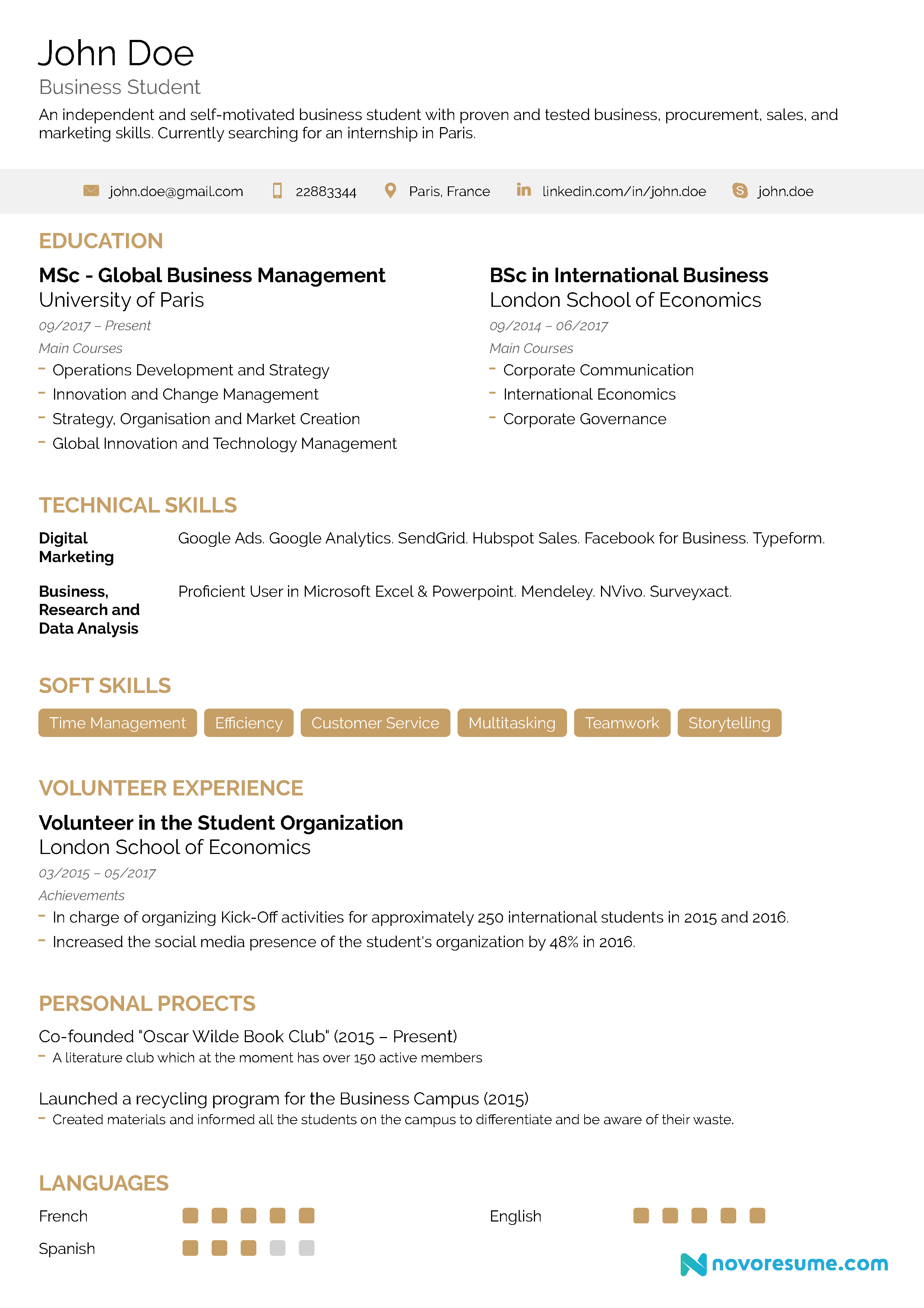
High-school Student Resume Sample
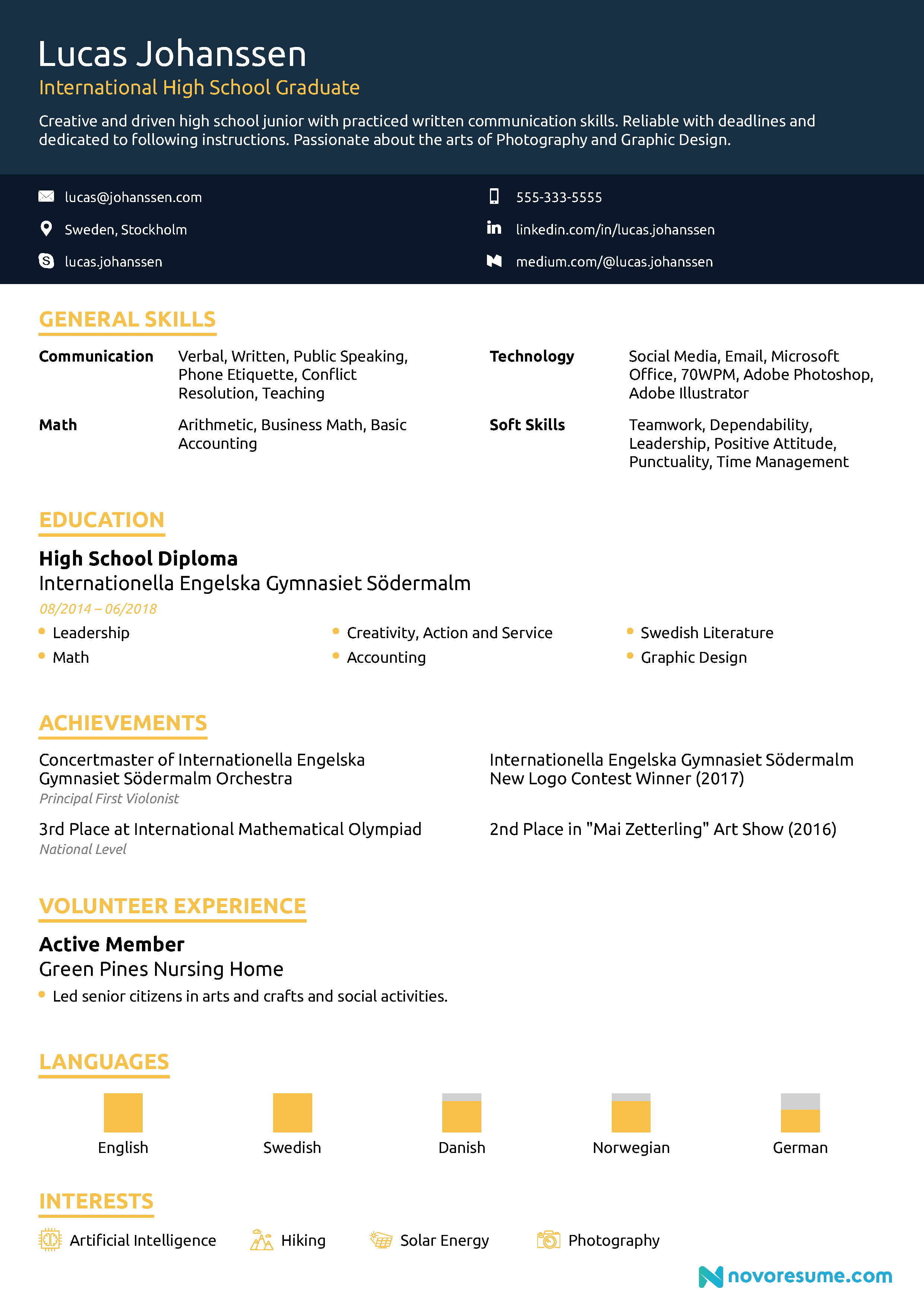
Create a Matching Cover Letter
All done with your resume?
It’s not over yet. You need to write a cover letter to go with it.
A cover letter is a single-page letter that accompanies your resume and is part of your job application.
Look at it this way: your resume describes your experiences, and your cover letter explains (in simple words) how they’re relevant to the job.
Now, here’s a quick infographic on what to include in a cover letter:

Finally, as with everything else in your resume, make sure to keep your cover letter relevant, short, and concise.
The hiring manager doesn’t have time to read an autobiography, they’ll only review your cover letter for a few minutes.
There’s a lot more to creating a good cover letter than what we just explained.
For a complete, all-you-need-to-know walk-through, check out our Complete Guide on How to Write a Cover Letter !
Key Takeaways
...and that’s a wrap!
At this point, you should know everything there is to know about writing a killer no-experience resume.
Just to keep things fresh, though, let’s quickly go through everything we’ve learned so far:
- When creating your no-experience resume, use the reverse-chronological format.
- You can create a killer no-experience resume by emphasizing your education instead. Include relevant internships, soft & hard skills, and projects.
- Other sections you can include on your resume are hobbies & interests, languages, certifications, or achievements.
- Keep all the content on your resume clear, precise, and relevant. Use bullet points for all your descriptions.
- After you’re done with your resume, you want to write an awesome cover letter that goes with it. The cover letter is a one-page letter that tells the story behind your resume content and reemphasizes why you’re a great fit for the job.
Related Resume Examples
- Internship Resume
- High School Resume
- Research Assistant Resume
- College Resume
- Students and Graduates Resume
- Teacher Resume
Recommended Readings:
- 43+ Resume Tips and Tricks to Land Your Next Job in 2024
- 20+ One-Page Resume Templates [Free Download]
- 35+ Common Interview Questions and Answers [Complete List]

To provide a safer experience, the best content and great communication, we use cookies. Learn how we use them for non-authenticated users.
How to Write a Resume With No Job Experience
Wondering how to write a resume with no experience? Here are some tips on what to include — like a professional summary, education details and relevant activities — as well as advice on what details to leave out of your resume.
Making a resume early in your career feels like a classic catch-22: A good resume highlights relevant work experience, which you don’t get until you land a job .
The truth is you don’t always need professional experience for entry-level jobs. By highlighting your existing skills, coursework and extracurricular activities, you can craft a resume that will impress employers — even without work experience.
Writing a Resume With No Experience
- Start with a professional summary
- Emphasize your education
- Include relevant experience like internships and extracurriculars
- Highlight your accomplishments
- Showcase your skills
- Don’t include a headshot, hobbies and other unnecessary details
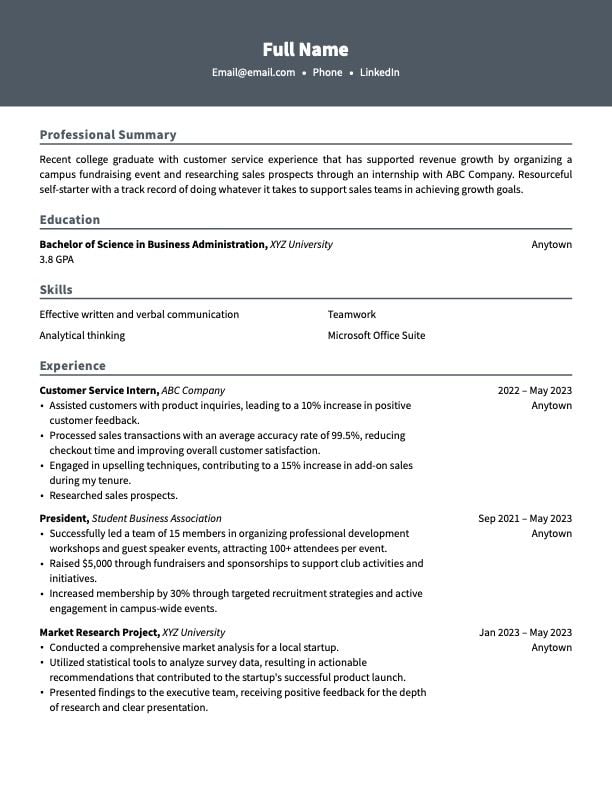
How to Make a Resume With No Experience
Even if you don’t meet all the requirements in a job description , there are still ways to write a resume that catches a company’s eye. First, choose a resume template (word processors like Google Docs and Microsoft Word have resume templates to guide you with a general structure). From there, you can fill in the details by following the tips below.
1. Start With a Professional Summary
Career coaches have mixed opinions on including a short professional summary at the top of your resume. Lesa Edwards, founder of Exclusive Career Coaching and the former director of the career center at Truman State University , favors a professional summary because it can set the stage and contextualize the experiences that follow. It also allows you to set yourself apart in a large stack of resumes.
If you decide to include a professional summary, ask yourself: What do I bring to the table? What soft skills could I transfer over to this role? What do I have that other candidates don’t have? If written well, this two-to-three-sentence summary could encourage recruiters and hiring managers to take a closer look at your resume and cover letter.
2. Emphasize Your Education
If you recently graduated from college, put your education experience as one of the first headers on your resume. List your major, any academic honors and your GPA (if it is 3.5 or higher). The education section of your resume can also include a subsection for industry-relevant certifications . As your career progresses, you can bump your education section further down the resume to make room for more relevant professional experiences.
3. Include Relevant Experience and Activities
Instead of focusing on the requirements you don’t meet, think about any transferable skills or experiences you might have gained from internships, extracurricular activities, part-time jobs, volunteering or school projects.
Jill Silman Chapman, director of early talent programs at Insperity , said she favors candidates who have a well-rounded set of experiences. It shows they are able to multitask, work in different types of environments and adapt to changing circumstances.
“In today’s workplace, we’re changing all the time,” she said. “That ability to adapt is critical.”

Internships
Internships are the best way to gain relevant work experience before entering the professional world. They offer an opportunity to apply the lessons you’ve learned in the classroom in real-world situations.
Part-Time Jobs
If you worked in a service industry job and you are seeking your first professional job after college, you could highlight soft skills , like time management skills needed to juggle school and work responsibilities. Customer service is an especially underrated skill, Silman Chapman said, because it translates to customer-facing roles and interpersonal skills within the workplace.
Extracurricular Activities
This could include student government, fraternities and sororities or any number of campus organizations or community activities. Athletics is also a resume booster in some industries, especially sales and other professions that tap into a competitive spirit. You might also note if you were an Eagle Scout, helped out at a peer tutoring program or volunteered your time in other ways that show you are engaged in your community.
Class Projects
Projects you worked on as part of a class or online certification program can also be incorporated into your resume. This could include your marketing class working on a semester-long campaign that culminated in a big presentation. If your class partnered with a company on a large project, that could be a relevant real-world experience for your resume.
Online certification programs are also a good way to gain professional experience, and often provide a chance to apply your learnings to a project, which can then be highlighted on your resume, said Karen Scully-Clemmons, assistant director of career services and employer relations at the University of Texas at Austin . You’ll want to detail what you accomplished, what technologies you used and what you learned . If possible, you should also link to your project on your resume.
Related Reading How to Use the STAR Interview Method to Land a Job
4. Highlight Your Accomplishments
For each experience you list, showcase the results in bullet point format, and look for ways to quantify your results. For example, don’t just rattle off what you did as president of a school organization, highlight how many new members joined during your tenure or how much money you raised while leading fundraising efforts.
These accomplishments don’t need to be groundbreaking, but you might have to reflect deeply and think creatively to recognize and articulate the value you provided in each role. Just be sure to align these accomplishments with the responsibilities in the job description .
“Sometimes I think the hardest thing for students is to think of an achievement, because they think it has to be a super big deal,” Edwards said. “So much of it is a shift in mindset of what constitutes an achievement.”
5. Showcase Your Skills
For a skills section, you can include your software proficiencies, as well as soft skills like organization, time management, communication, adaptability to change and the ability to work as part of a team. If you are going to highlight soft skills , though, you should also include evidence of a role or situation in which you demonstrated those skills.
“It may not be numbers, dollars or percentages,” Edwards said, “but maybe you could talk about how you took a leadership role in a class project that was presented to a community organization.”
Related Reading 5 Things New Grads Need to Know About the Job Market
6. Don’t Include These Elements
You only have so much space on your resume, so be sure to leave off these unnecessary details.
Objective Statement
Don’t include an “objective” statement that lays out what you are looking for in a job. Instead of talking about what you want, use that space to describe what value you can offer the employer.
Hobbies and Interests
While you might think a job is related to your hobbies and interests, Edwards said these are of little practical interest to recruiters and hiring managers. Leave them out of your resume.
A GPA below 3.5 is not likely to win over a company, and a GPA below 3.0 could only hurt your chances. Only include your GPA if it’s above 3.5.
Headshot or Photo
Recruiters and hiring managers don’t need or want to see what you look like. Unless you are applying for an acting job, don’t attach a picture to your resume because it could be potentially used to discriminate against you.
Your Full Address
In the electronic age, there is no need to put your address on your resume. Providing your city and state is typically enough, unless an online application requires your full address.
Graphics
Don’t employ resume templates with fancy graphics: most companies use applicant tracking systems (ATS) , which can’t read resumes that are decorated with graphics, special fonts, columns and other formatting tools.
Frequently Asked Questions
What can i put on my resume if i have no experience.
In lieu of professional experience, you could highlight your education, skills, internships, extracurricular activities, part-time jobs, volunteering experiences and school projects.
How to write a professional summary for a resume with no experience?
A well-written professional summary will draw upon the experience you’ve gained from school, internships and other extracurricular activities to demonstrate the impact you have made and the value you would bring to your desired role.
How do you say you have no experience but are willing to learn?
Employers are often willing to train entry-level candidates who have shown initiative and a hard work ethic in school, internships and extracurricular activities. You can emphasize your willingness to learn through your professional summary statement on the top of your resume or through the cover letter that accompanies the resume.
Do I need a resume if I don't have experience?
Yes, you need a resume when applying for a job, regardless of your experience. Most word processors, like Google Docs and Microsoft Word, offer free resume templates to get you started.
Is it bad to have no work experience on a resume?
Having no work experience on a resume isn’t a bad thing, especially for entry-level roles. But be sure to include any internships, part-time jobs, volunteer projects, extracurriculars and other relevant experiences to make up for a lack of work experience.
Recent Career Development Articles

Write a resume with no experience
When you’re looking to land your first job, your resume needs to impress employers.
If you have little or no work experience, this can be tough.
But, with the right structure and approach, anyone can write an interview-winning resume.
This detailed guide, which includes a resume example, will show you how to write a resume with no experience, that will still impress recruiters, and take you one step closer to landing that first job.
- Resume examples
- Structuring and formatting your resume
- Writing your resume summary
- Your education
- Vital skills for your resume
Resume templates
Resume with no experience example
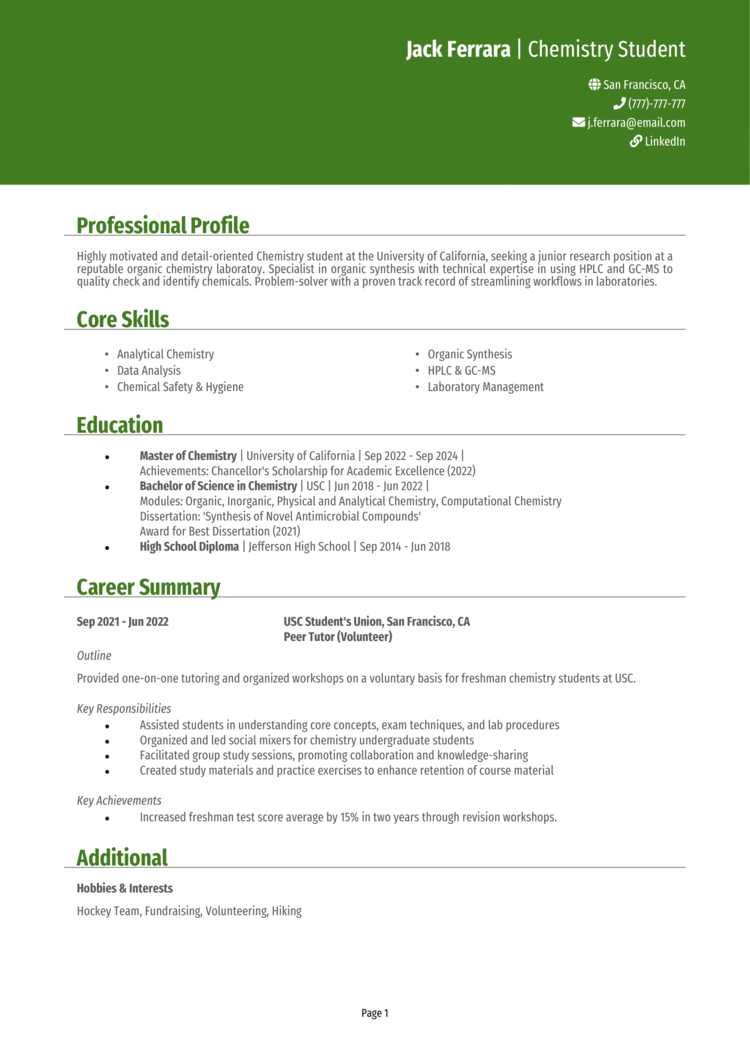
This resume example shows you the basic format of a resume, and the type of content you can include when you have no experience.
I will now walk you through how to produce your own effective resume.
You can watch the video below or read through the rest of the guide on this page.
Top tips for writing a resume with no experience
- Although you may have no formal work experience, be creative and fill your resume with anything that can demonstrate your workplace skills
- Use hobbies, interests, after-school clubs, sports teams and volunteering to highlight transferable skills
- Head your resume with a punchy summary or personal statement to sell yourself to employers and explain why they should hire you
- Make your hard skill such as languages, IT software and written communication highly visible
- Provide lots of detail on what you have learnt in school to make up for your lack of experience
Resume structure & format
The key to getting recruiters to notice your resume, is having a structure that enables ease of reading and allows them to quickly navigate your educational background and relevant skills.
Using sections to clearly identify your transferable skills, assisting you in securing an interview.
This infographic will support you in creating a simple-but-effective format and show you what sections to include in your resume
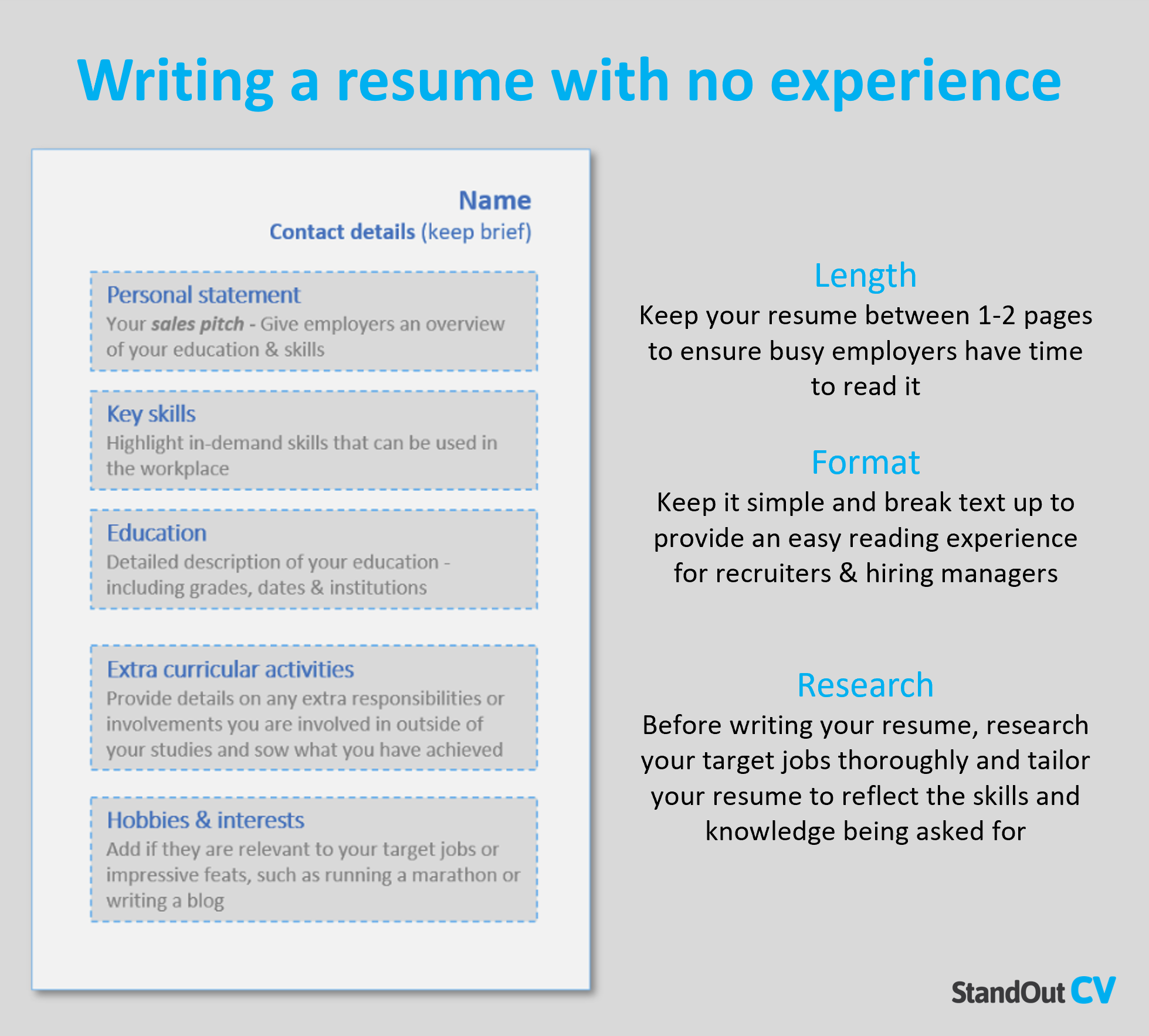
Formatting Tips
- Use bold headers, bullet points and sections to break up information and support recruiters in easily navigating your resume
- Don’t over-design your resume with imagery such as company logos or headshots and instead keep to a subdued color pallet and a clear font
- Maintain a resume length of 2 sides of A4, don’t look to add irrelevant information to fill space and be comfortable with submitting a resume that is 1 to 2 sides
Structuring your resume
Highlight essential information within your resume by breaking up large blocks of text and working to a format that focuses on your relevancy for the sector you’re looking to apply to.
Stick to the below format when putting together your resume:
- Contact details – Make your contact details easily accessible at the top of the page
- Summary – Start your resume will a short paragraph summarizing your skills and qualifications, engaging recruiters to read further
- Education – Display your qualifications, especially those most applicable to the industry you’re looking to apply to
- Work experience – If you have any, detail voluntary experience or any part time employment
- Interests and hobbies – Look to add hobbies that document your transferable skills, providing added value to your resume
You can always use a resume template , if you want to make the structuring process easier and quicker.
Resume contact details
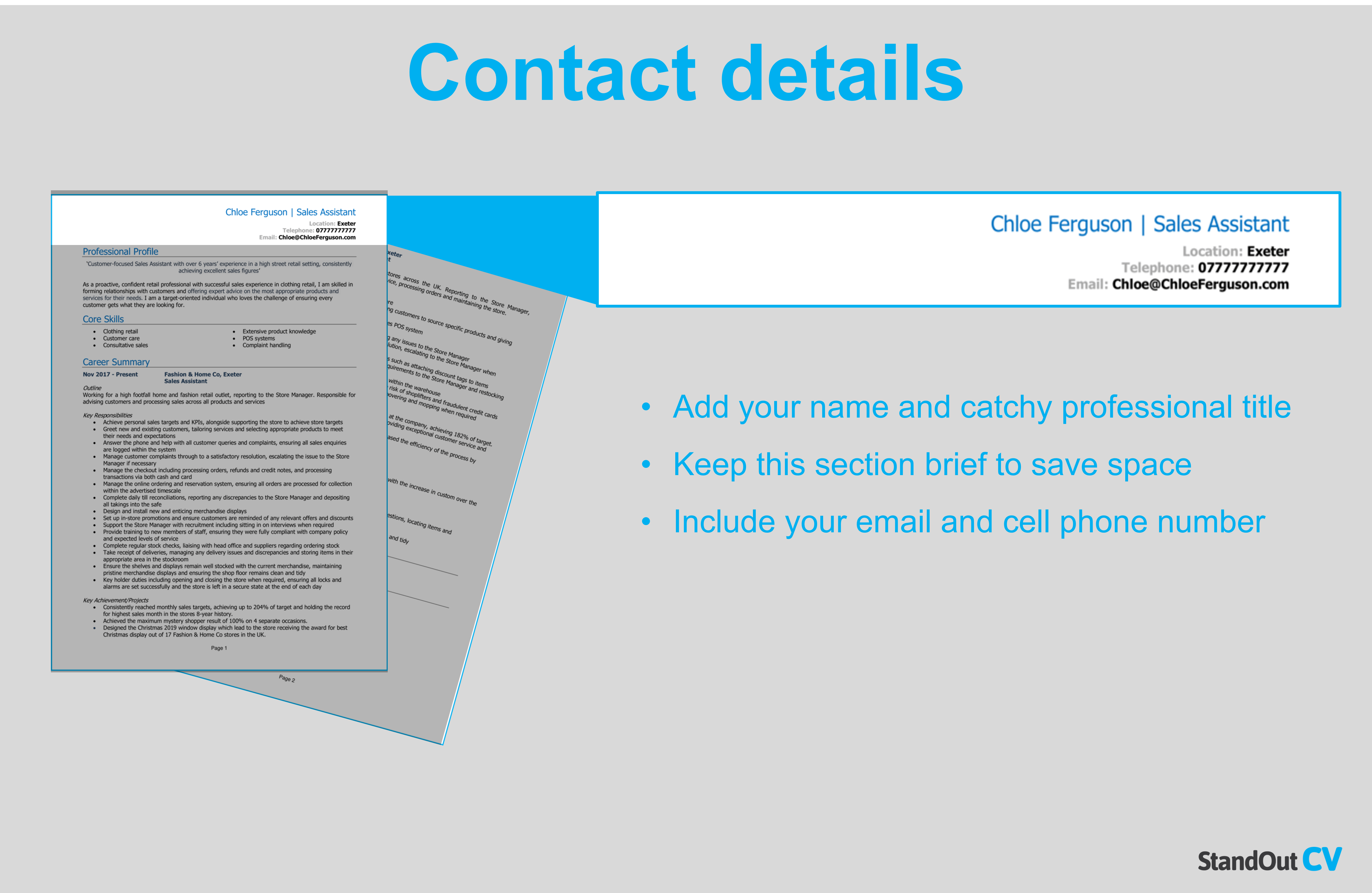
Keep your contact information to the top of your resume, allowing recruiters to easily reach you.
Stick to the essential information as seen below:
- Phone number
- Email address
Remove supplementary information such as marital status, profile pictures or date of birth that aren’t required in your application.
Quick tip: You can save space and add some design flair to your resume by adding some icons to symbolize the contact details in your header.
Resume summary
Start your resume with an attention-grabbing introduction, summarizing why you’re the ideal candidate for the positions you are applying to – in a punchy summary .
Give recruiters an insight into your background and core skills, making your educational history a focal point, displaying your interest into your preferred field – give them some good reasons to consider you.
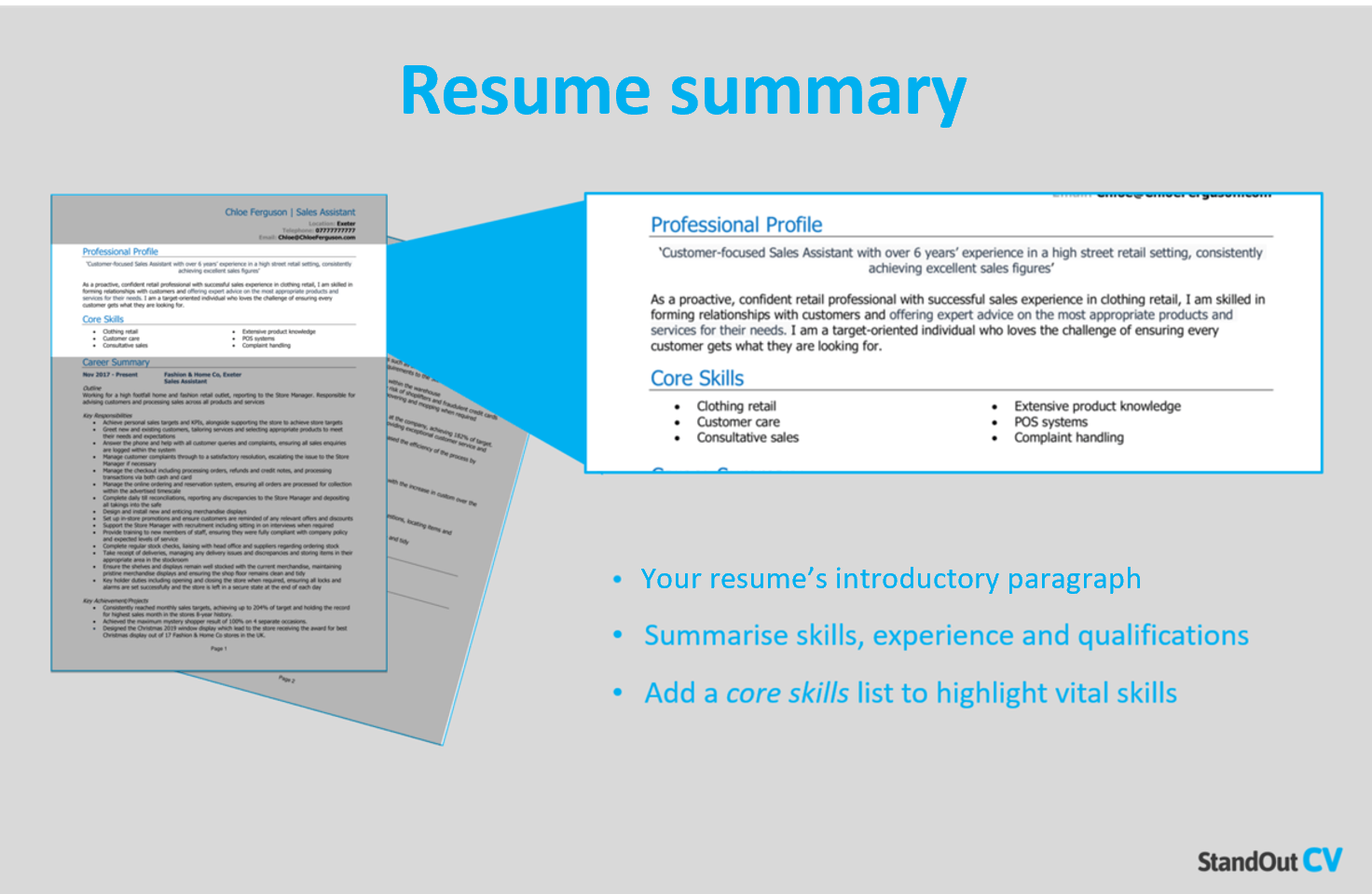
These tips will support you in producing your resume summary :
- Research your chosen industry prior to creating your summary, making yourself custom-fit to the sector, adopting sector specific keywords
- Your summary should be between 5-10 lines; you’ll be able to elaborate elsewhere in your resume
- Avoid cliché and overused statements such as “I am punctual” or “I am hardworking” and instead, try to include key requirements from the job adverts you are applying to
What to include in your resume summary?
- Qualifications – Make your education a focal point, considering qualifications most imperative to the industry you’re pursuing
- Core skills – Document any transferable or marketable skills you’ve acquired in school or university, reflecting on strengths such as interpersonal skills , problem solving, or any skills that can translate into the workplace
- Passions – Why are you interested in pursuing your chosen career? What makes you a good fit?
Core skills & achievement section
Underneath your resume summary, add a skills section that consists of your core skills, using two to three columns of bullet points to list these strengths.
Allowing recruiters at first glance to establish your most applicable soft and hard skills, which relate to the industry you’re pursuing.
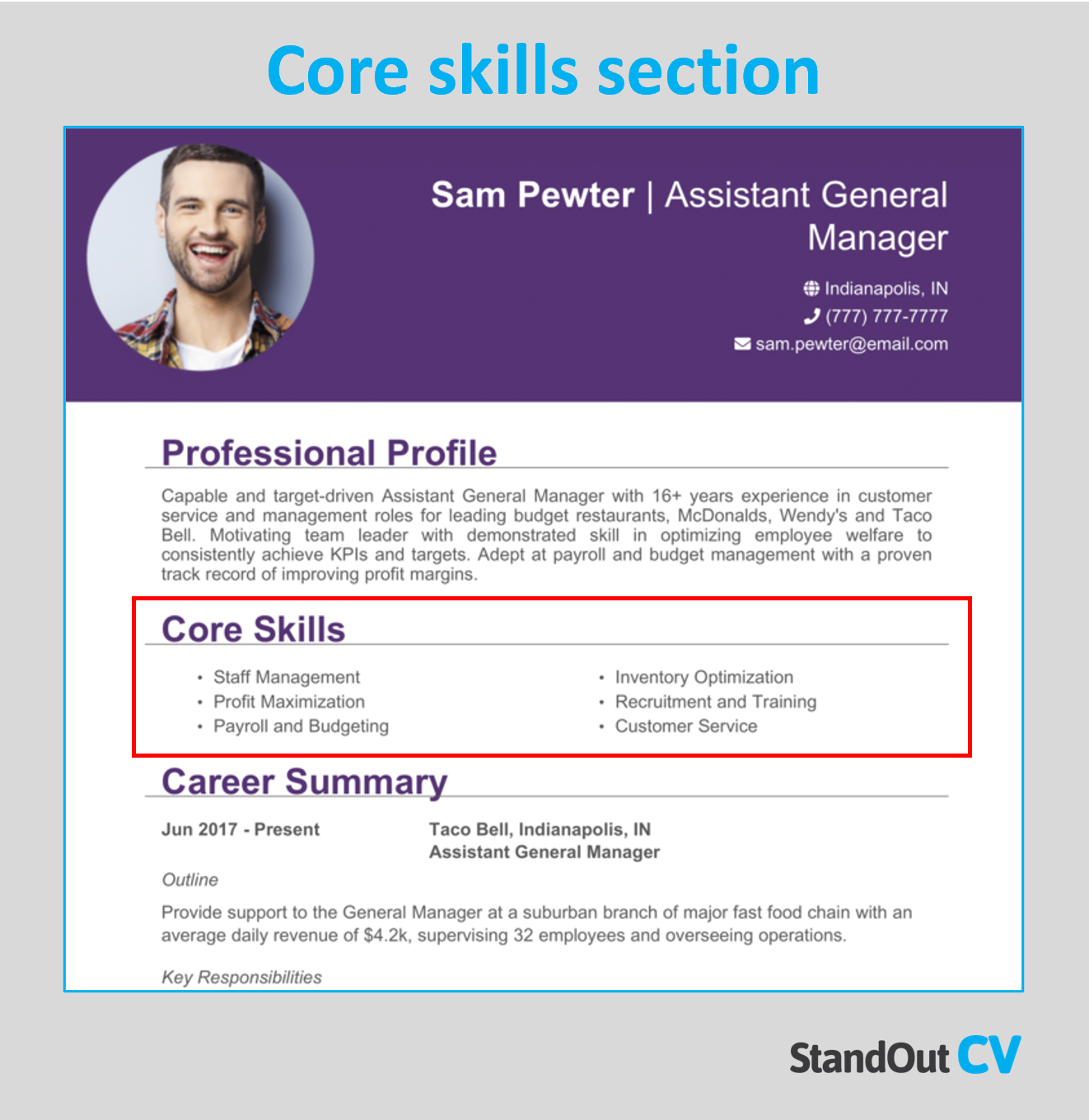
Before putting together this section, look to research the industry you’re applying to, adding keywords that make you custom fit to that sector.

When you’ve limited or no work experience, use your educational history as a focal point of the resume.
Represent the qualifications you have achieved as well as describing examples of coursework completed and including any specific accomplishments from your educational history.
Break up this information by clearly heading the type of qualification achieved, the dates obtained and the school or college you attended.
Use bullet points to list the qualifications you secured.
Clubs and Memberships
Within your education section look to incorporate the clubs you were part of and your role within that group.
For example, whether you were the captain of a football team or a prefect at school, even considering adding any charity work you may have done.
When writing about these; try to draw out relevant skills such as teamwork, leadership, communication etc.
See also: Graduate resume – Student resume
Work experience
Although you may have no formal work experience – be creative and add anything that could be demonstrate workplace skills, such as:
- Big projects
- Work experience placements
- A weekend job
- Volunteering
- Club or sports team membership
Quick tip: If you have no work experience, pick up a volunteer role so that you have something impressive to add to the resume.
Structuring your roles
If you have anything you could add as work experience – add to your resume like the below example.
Structure the information within your roles, by breaking up large blocks of text and using bullet points, and defined sections.
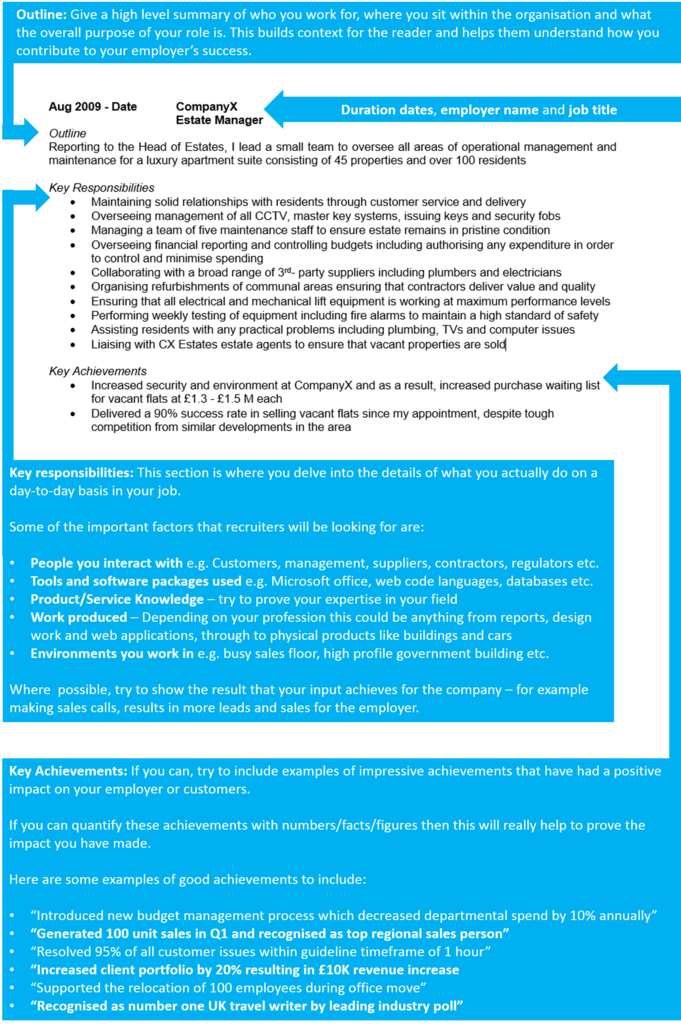
Give an overview of your voluntary position, what were your duties or what skills you obtained from this experience.
“Working in a busy café supporting the kitchen and front of house staff to ensure customers have a clean and safe environment .”
Key responsibilities
Use bullet points to document any duties you had within a position.
- Interacting with the waiting and kitchen staff to collect dishes and cutlery
- Supporting kitchen preparations during opening and closing of the café
Key achievements
Document any key achievements whilst in these positions, add relevant examples integrating any facts and figures to verify these where applicable.
- Achieved employee of the month, 2 months in a row
Interests and hobbies
When you have no experience, your hobbies could help boost your application , documenting your transferable skills gained within them.
Emphasize involvement in any clubs or teams, describing the contribution you had and providing any result driven examples.
Impressive hobbies for your resume could include:
- Being in a sports team
- Being a member of a club (book club, chess club)
- Writing a blog
- Building models or machines
- Running a marathon
- Taking part in school schemes
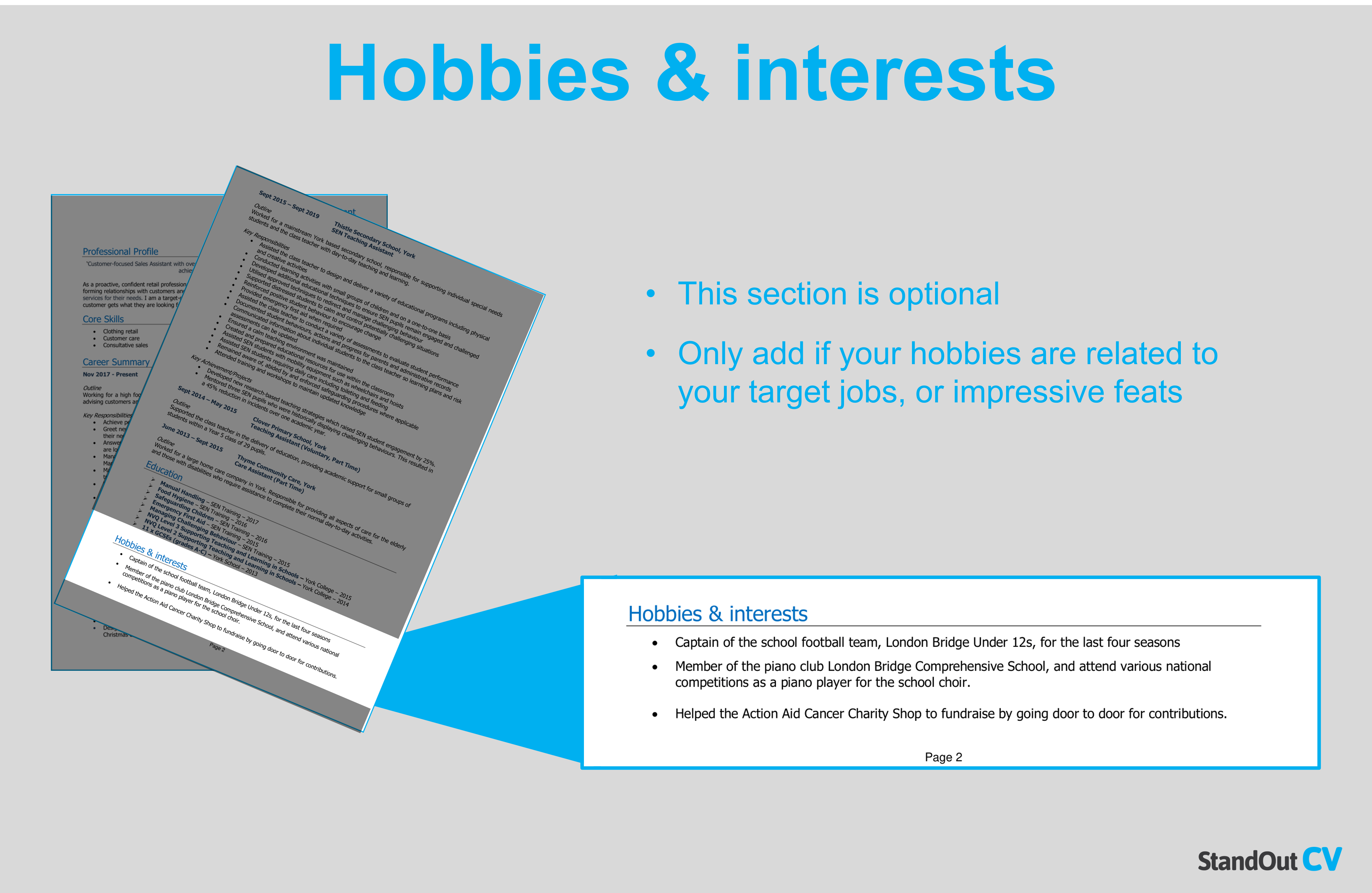
Look to display your personal pursuits, even if these interests don’t directly correlate to the industry you’re applying to, reveal how you can use the experience or skills gained within the industry you’re pursuing.
For example, if you’re looking to gain employment in technology then exhibit your passion for working with computers and the skills you’ve gained such as the ability to solve problems and work methodically.
Essential skills for your resume
Portray the skills you have obtained throughout your experience in education, placements or extra curriculum activities, explaining how these can transition into a work environment.
Look to include these fundamental skills:
Communication – the ability to speak with people of a variety of levels, whether teachers, professors, customers or colleagues
Organizational Skills – the ability to juggle studies whilst taking on voluntary work.
Teamwork – the capacity to work within a team to overcome obstacles and achieve common goals, whether in a school project or extra-circular team
Commitment and Drive – showcase your passion and commitment towards your chosen career path.
Customer Service – a talent for putting customers first and going the extra mile.
Writing your resume with no experience
When you have no work experience, your resume is your first impression in the recruitment process and your opportunity to display what makes you an ideal candidate.
Highlighting all aspects of your educational background as well as the skills that make you applicable for the industry you’re looking to transition into.
By using this guide, you’ll be able to produce a well-structured resume that will assist you in obtaining your dream career.
Good luck in your next application!
Soft Skills
14 minute read
How to Write an Impressive Resume With Little Experience

Kat Boogaard
Facebook Twitter LinkedIn WhatsApp Email
You’re starting your job search, and you’re feeling ready to tackle things head on. You’ve given your network a heads up that you’re looking for a new opportunity, you knocked the digital cobwebs off of your LinkedIn profile, and you’ve bookmarked some of your favorite job boards .

Sure, you’d have plenty to say if you had years of experience under your belt. But, whether you’ve just graduated or are making a career change, you’re totally new to this industry and don’t have a ton of relevant work history to showcase.
You’re stuck in that vicious cycle that way too many job seekers are familiar with: you need experience to get a job, but you need a job to get experience. Now what? Cue the groans, eye rolls, and exasperated sighs.
Let’s explore how to write a resume with little experience.
Want to learn more?
Take your soft skills to the next level with our comprehensive (and free) ebook!
How to write a resume with little experience: 7 must-know tips to get to the top of the pile
Yes, figuring out how to write a resume with little experience can be a disheartening exercise, but it’s certainly not an insurmountable challenge (after all, everybody starts somewhere!).
Let’s cover some strategies you can use to call attention to your best attributes and get yourself one step closer to landing the interview — and maybe even the job.
1. Take a fine-tooth comb to the job description (and use those keywords!)
It’s tempting to think of your resume as your personal sales sheet of sorts. You feel like you need to cram every positive thing about yourself (from your dozens of skills to your numerous accomplishments) into those margins, so you can seem as impressive as possible.
But here’s what you need to remember about your resume: it’s not designed to share everything about you. It’s meant to demonstrate relevance to whatever job you’re applying for.

What exactly does that mean? You’ll start by taking a super close look at the job description — seriously, print it out and grab a highlighter. Now, look for requirements, responsibilities, and skills that are emphasized. For example, perhaps you see several mentions of “being a team player” and “collaborating with a team.”
Obviously, the employer has made it clear that teamwork is an important competency for whoever fills that role, so that’s something that should be emphasized on your own resume (provided you honestly possess that skill, of course).
List “teamwork” or “collaboration” as a bullet within your skills section , and include your ability to thrive in a team setting in your summary (don’t worry, we’ll cover both of these sections in detail a little later).
Not only does using this strategy clearly draw parallels for the hiring manager, but it will also help you make it past any Applicant Tracking Systems (ATS) the employer might have in place.
These systems are the scary robots who scan your resume before it ever makes it in front of human eyeballs. To put it simply, if you don’t have the correct keywords that have been predetermined by the company, you won’t make it through that initial filter. It’s yet another reason why tailoring your resume for every single job is an important habit to get into.
2. Get creative and explore different resume structures
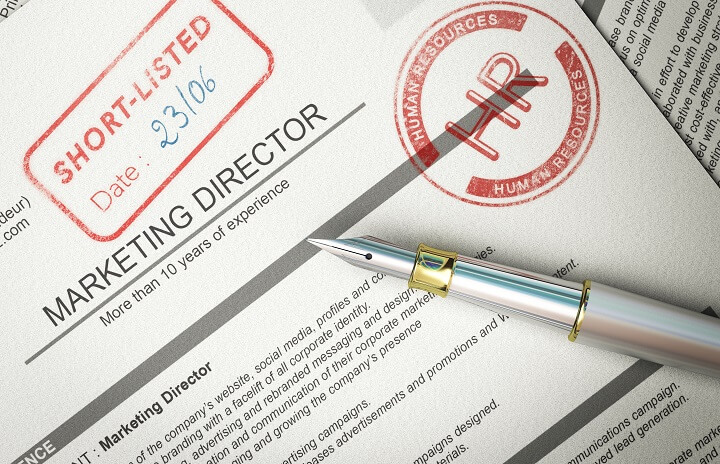
While that’s the most common format, it doesn’t mean it’s the best one for you. If you don’t have a ton of relevant work experience to highlight, then why would you want the majority of your resume to be dedicated to that history?
Instead, look at using what’s called a functional or a skills-based resume . This format includes a lot of the tried and true resume sections you’ve come to expect (like a summary and education), but it draws less attention to your work history and more attention to your skills.
Using this structure, you’d bucket your skills into different categories. For example, if you’re applying for your first digital marketing role, perhaps you’d identify the following categories of skills:
- Social Media Management Skills
- Analytics Skills
- Graphic Design Skills
- Interpersonal Skills
You’d list those categories on your resume, and underneath each you’d dedicate a couple of bullets to talking about what you bring to the table in that category. Here’s a quick peek at what that could look like for one of these categories:
Social Media Management Skills:
- Experience using a variety of popular platforms (including Buffer, Hootsuite, and Sprout Social) to manage and monitor numerous social media accounts.
- Created a comprehensive social media marketing plan for Sacramento State University’s campus-wide volunteering day.
Pretty impressive, right? Especially when you consider that neither of those bullets relate to this person’s work history — those were skills and accomplishments they picked up through things like coursework, extracurriculars, and volunteer work.
That’s the beauty of a skills-based resume. It allows you to shine the spotlight on your most relevant and notable qualities, even if they have nothing to do with your work history.
Of course, you should still list any previous jobs to show that you have work experience. But, those can be listed at the bottom of your resume with very little detail like this:
Waitress | ABC Bar and Grill | Sacramento, CA | Sept. 2018 - Dec. 2019
Customer Service Representative | Company XYZ | Sacramento, CA | June 2017 - July 2018
Are you too intimidated by starting with a blank document? Grab a free Microsoft Word resume template right here . Yep, there’s even a skills-based one you can use.
3. Think outside of the box (and your work history)
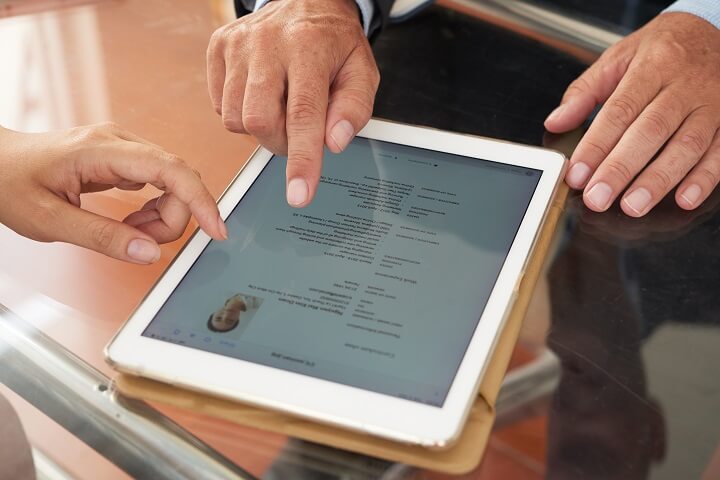
What they really want to know is that you have the skills and knowledge to succeed in that role — and it typically doesn’t matter to them as much how you went about getting that knowledge.
Were you involved in a bunch of extracurricular activities? Are you committed to volunteer work that allows you to try new things? Do you keep yourself busy with a bunch of side hustles or passion projects? Have you advanced your education and skills development through online courses (like you can do with GoSkills)?
You don’t need to earn a paycheck from something in order to include it on your resume. The above are all worthwhile endeavors and accomplishments that you can showcase to demonstrate relevance. So, don’t fall into the trap of only thinking about your day jobs, and challenge yourself to get creative.
Additionally, if you have supplemental materials (whether it’s an online portfolio, a macro you created in Excel , or an app you designed in your free time) to include with your resume, don’t hesitate to send those in too. Those materials provide hard evidence that you don’t just talk the talk — you can actually walk the walk too.
4. Use a professional summary to set the stage
If you’re still using an objective statement (that’s the quick line that says something like, “Recent graduate seeks entry-level position in the digital marketing field”) at the top of your resume, you can go ahead and kick that to the curb right away.
Objective statements have gone by the wayside in the job search, because they really don’t do anything but state the obvious. Everybody who’s applying for a job has the same objective: to get the job they’re applying for. Otherwise they wouldn’t bother tossing their hat into the ring.
Instead, opt for a professional summary. It’s a short paragraph (usually about three to five sentences without using any personal pronouns), that brings all of your most relevant skills right up front and introduces you as a candidate.
Particularly if you’re someone without a lot of relevant experience, this summary gives the hiring manager your greatest highlights, and also arms them with some context to keep in mind as they’re reviewing the rest of your document.
Sticking with our digital marketing example, here’s a look at what a summary statement might look like:
Recent graduate of Sacramento State University with a Bachelor’s Degree in Marketing Communications and a minor in Graphic Design. Proficient with a variety of marketing tools and programs, including Adobe Creative Suite, Google Analytics, Mailchimp, and more. Highly self-motivated, skilled communicator, and a dedicated team player.
Keep in mind that this is another place where you should be referring back to the job description. Any must-have things you see listed there should be injected into your own summary, so you hit the hiring manager with that information right away.
5. Give yourself the six second test
The average recruiter or hiring manager spends only six seconds reviewing your resume before deciding how to move forward. That’s it. Count to six right now, and you’ll realize that’s barely any time at all.

Yes, heat map studies show that they are going to look at your work history. However, they also pay close attention to your education. So, provided it’s relevant for the roles you’re applying to, include your education near the top with a bold header, so that employers can quickly spot those details.
Once you have a rough draft of your resume in hand, set a timer for six seconds and take a look at your own document. Is it easy to read? Is it neatly organized and digestible? Can you get a grasp of the nuts and bolts in a short amount of time?
Really challenge yourself and be honest here. The better your resume does during those six seconds, the higher your likelihood of ending up in the “to be interviewed” pile.
6. Lean on your cover letter to tell your story
Your resume does most of the legwork, and it’s really your golden ticket in the door for a job interview .

Particularly for career changers or people with little experience, a cover letter can be a great addition to the materials you submit with your job application. It allows you to not only use personal pronouns, but also to tell more of your story and fill in any of the gaps or questions that might come up based on your resume alone.
The best way to think of your cover letter is as a trailer to a movie. Use it to highlight your most impressive and relevant qualifications, so that the hiring manager wants to review your resume in detail for more information.
Struggling to figure out what to include? In addition to turning your attention to the job description (remember, that’s your best friend here), ask yourself this: If you could only tell the hiring manager for that position three things about you, what three things would they be? Those are elements you should definitely incorporate into your letter.
Want to make writing your cover letter even easier? Check out this template .
7. Proofread your resume (and then proofread it again)
Whether you’re somebody with decades of experience in your field or you’re just getting your feet wet, it’s important to proofread your resume carefully. Extremely carefully.
77 percent of hiring managers say that typos or bad grammar are instant deal breakers when they’re reviewing resumes from candidates. You’d hate for a misspelled word or misplaced period to be the reason you’re destined for the recycling bin.
When you’ve been staring at your own resume for hours, it’s way too easy to miss small mistakes (particularly the ones spell check doesn’t point out). So, try reading it backwards — from the bottom up. This will force your brain to focus on each individual line and make you far more likely to catch any blunders.
Want to be extra safe? Have a friend you trust review it too. In addition to providing some helpful feedback about the actual content, they can help you spot any mistakes that snuck past you. After all, there’s nothing more embarrassing than saying that you’re “detail-oreinted.”
Don’t have a lot of experience? Your resume can still set you apart
Writing your resume is probably not something you’ll ever look forward to, but it can feel extra daunting when you don’t have a lot of relevant work history or experience to showcase.
The worst thing you can do is to count yourself out of the running for a position simply because your past jobs don’t line up perfectly. If you still feel that you have skills and knowledge that qualify you for that position, it’s worth applying with a resume that shows what you’re made of.
Use the above tips to create a document that captures all of your best qualities and minimizes the not-so-pertinent ones. You’ll be one step closer to scoring that interview invite . Good luck!
Online courses are a great way to build your knowledge while also beefing up your resume. Check out GoSkills courses now to expand your learning horizons and stack your resume with impressive skills.
Gain the soft skills employers want
Start learning for free with GoSkills courses
Loved this? Subscribe, and join 468,331 others.
Get our latest content before everyone else. Unsubscribe whenever.

Kat is a writer specializing in creating online content for software clients in the training, careers, self-development, human resources, productivity, project management, and business ownership spaces. Her content has been published and/or syndicated by brands such as The New York Times, Forbes, Fast Company, Inc., Business Insider, TIME, Mashable, and LifeHacker. Beyond writing, she has had roles in marketing, public relations, and has worked as an employment advisor. When she escapes her computer, she enjoys reading, hiking, golfing, and dishing out tips for prospective freelancers on her website. . Find her on Linkedin here.

Recommended
Why Employers Will Value Soft Skills Over Tech in the Age of AI
As AI becomes ubiquitous, it's becoming increasingly difficult to stand out. Learn how to use your soft skills in a tech-saturated environment.

How to Hire the Right Candidate for the Right Job
When using the right strategies, hiring the right job candidate can be seamless and effective.

7 Essential Skills To Help Startups Meet New Challenges
Startups and SMEs face specific challenges that threaten their survival. Make sure your business' growth doesn't lead to its downfall with these 7 tips.
© 2024 GoSkills Ltd. Skills for career advancement
🍪 This website uses cookies to improve your experience.
Learn more about our cookies Accept cookies
How to Write a Resume When You Have No Experience
Marc Andre, Contributor
- Updated August 12, 2024
When you have no experience, getting the attention of hiring managers or HR professionals can be a challenge.
The good news is that everyone starts somewhere, and overcoming this challenge is possible. If you know how to write a resume without experience, you can still stand out despite having no job history to show.
In this article, we’ll go over exactly how to structure this type of resume, including what to include and what to leave out. At the end of the post, you’ll find a customizable example template.
Table of Contents
What Your No-Experience Resume Needs to Accomplish
Most job openings draw a massive number of applicants — sometimes hundreds or more for a single opening.
The goal or purpose of a resume is to help you stand out from other applicants and get to the next stage in the hiring process , which is an interview.
A seasoned professional with years of experience will use their work history and career accomplishments to stand out from the pack. Your resume can accomplish the same thing with no experience, but you need to go about it differently.
Since you can’t rely on employment history to prove your capabilities, you’ll need to catch the attention of the HR rep or hiring manager in other ways.
Your no-experience resume should :
- Show the relevant skills and experience you do have.
- Communicate your interest in the job and willingness to learn.
According to career strategist Linda J. Hollenback, MSEd, CPRW of Hollenback Consulting , you should think of this type of resume as a conversation starter.
“The resume’s purpose is not to get [you] a job, but to open the door for an interview, a conversation with the hiring manager,” Hollenback says. “The resume should showcase not only what you’ve done, but what skills, qualities, and value you bring to the team, company/organization, or client you serve.”
Your no-experience resume can and should communicate these same things. In other words, you need to highlight your skills, qualities and the value you would bring to the team or company if they hired you.
Plus, you may very well have more experience than you think. Katelyn Richards, a career coach from Crafted Careers, says that it’s important to redefine what “experience” means.
“We all, ultimately, have experience,” she says. “Life is filled with it. If you’re younger and haven’t had a professional job, your experience is just more limited, but it is by no means non-existent.”
Richards says to start by highlighting relevant experience — even if it isn’t directly related to the job you’re applying for.
“There’s a reason why this particular role is of interest to you. You have relevant skills. Otherwise, you wouldn’t believe you could do this job. It might be from school or from a job we had as a teen. Either way, [you] want to name these.”
According to Richards, that relevant experience could come from:
- Academic projects
- A non-related job (full time, part-time or seasonal)
- Side projects (including things like side hustles and Eagle Scout projects)
- Freelance work (even if not paid)
- Volunteer experience
- Clubs and organizations
- Leadership positions
Another way to stand out is to show the capability and willingness to learn. Global HR advisor, coach, and recruiter Anne Campbell from DigitalGrads says, “Your resume should leave the reader in no doubt that you are keen to learn and have the aptitude for the role even if you haven’t worked before.”
You can do this with a well-written summary and cover letter (we’ll look at the summary and cover letter in more detail later in this article).
It’s also important to understand that applicants for entry-level jobs are typically not expected to have experience.
Amy C. Waninger, diversity and inclusion expert and CEO of Lead at Any Level , says that for these types of positions, prior experience may not be an expectation. “Instead, [the recruiter or hiring manager] is looking for indicators that you will be a good employee. If you are a student or recent student, you can probably demonstrate these characteristics through activities other than work experience.”
What to Include
Let’s take a look at the specific sections to include in your no-experience resume, so you know exactly how to create your own.
Section 1: Header
At the top of your resume, include your contact information:
- Address (optional)
- Phone number
- Email address
- LinkedIn profile (optional)
Section 2: Summary
In the past, most resumes started with a career objective, which could have included things like your long-term goals.
The summary is a modern replacement for the objective. It should highlight your qualifications for the job clearly and concisely. Here, you’ll mention skills, accomplishments, or non-work experience that quickly demonstrates your capabilities.
Dr. Deb Geller, Associate Dean of Students at UCLA , says that your summary statement should be the equivalent of an elevator pitch. “In one short paragraph, it summarizes your strengths and experiences, states the type of position you are looking for, and connects the dots to show how you are prepared to succeed on the job.”
Remember that HR reps and hiring managers likely received many resumes for the position, which means they’ll make quick decisions before moving on to the next applicant. They won’t read every word of every resume they receive, so the summary is your opportunity to capture their attention quickly.
Section 3: Education
The education section of a resume is crucial for applicants with no job history. You need to maximize any advantage you have, including any awards, honors or scholarships you earned.
Recent grads may also want to include relevant coursework that’s highly applicable to the job. Listing some of the courses you’ve completed will make your education section more robust, and it can help offset a lack of work experience.
There’s some debate as to whether you should include your GPA on your resume. The consensus is that you should list the GPA if it’s strong (over 3.0). With no work experience, your education is one of the most critical aspects of your qualification for the job. If you have an excellent GPA, use it to your advantage. If your GPA was below 3.0, don’t include it on the resume.
Section 4: Experience
Even though you have no job history, you have some type of experience. The key is to identify the experiences you have that are relevant to the position you’re applying for and use the experience section to show a relationship between your past and your ability to excel in the role to which you’re applying.
There are two main types of resumes: chronological and functional. The chronological resume lists experience in chronological order, with the most recent at the top. The functional approach lists the most relevant or most crucial experience first, regardless of the timeline.
If you have no job history, the experience section of your resume should take a functional approach, which ensures that the most important details are listed first.
Note: With no job history, you probably don’t want to title this section of your resume as “Work Experience.” Consider using “Experience” or “Relevant Experience” instead.
What should you list? There are plenty of ways to gain experience outside of a job. For recent college graduates, the things you did during college will be the most recent and likely the most significant, but you can also include experience before college.
Some possibilities include:
- Personal projects or side hustles
- Internships
- Leadership or student government roles
- Participation on committees
- Courses or certifications you’ve completed
- Participation in sports or extracurricular activities (especially if you were a captain or had a leadership role)
- Community involvement
Experience doesn’t have to come through work. The experience you’ve gained outside of a job could be even more valuable and more appealing to the hiring manager.
Adam Gingery, chief operating officer for Majux Marketing , says, “If you have no official work experience, you can very easily catch my attention by giving me a resume of projects you’ve undertaken on your own.”
Gingery says that concrete examples demonstrate enthusiasm, the desire to learn, discipline and work ethic. “Things that a year or two of work experience don’t prove in the least.”
As you’re crafting this section of your resume, focus on transferable skills. For example, a position in student government may have allowed you to develop strong problem-solving skills and taught you how to work well with others. The specific experience you gained in student government may not be relevant work experience to the job you’re applying for, but these skills will transfer and be helpful in the role.
Focus on demonstrating the transferable skills you’ve developed through your experience. If possible, use the exact keywords or buzzwords that appear in the description of the job you’re applying for.
Although it won’t help you immediately, you may also want to consider volunteering or finding opportunities to get involved in the field you’re looking to pursue.
“If you have no work experience, consider starting your own project or volunteering your time to get the ball rolling,” says Eropa Stein, founder of the HR software firm Hyre .
“For example, if you are looking to get into HR, you may volunteer to help with HR at a non-profit. If you are looking to enter a business development field, consider doing a case study on an existing company. Find opportunities wherever you can to create experiences for yourself that are related to your ideal position. Add these experiences to your resume and go into detail on what you accomplished.”
Section 5: Skills
The skills section of your resume should be brief, but you want to highlight your skills that are most relevant to the specific job you’re applying for. Rob Hernandez, founder of Pounse (a talent platform for schools and students), recommends using bullet points with 8-10 words that describe how you used that skill in context.
Be sure to include a combination of both hard skills (writing, coding, etc.) and soft skills (communication, leadership, etc.). And just as with the experience section, you want to focus on transferable relevant skills.
Zoë Morris, president of the recruitment firm Nigel Frank International , says to hone in on anything that could be useful in the role you’re applying for.
“A lot of desirable traits that hiring managers are looking for in a candidate are the soft skills that are very difficult to teach. In that sense, where you’ve learned these isn’t as important as the fact that you’re able to demonstrate them. If you’re a great communicator or problem solver, or can work well under pressure, these are skills that can be developed outside of the workplace and transferred between seemingly completely unrelated roles.”
What to Leave Out
Now that we’ve covered the details of what to include in your resume, let’s take a quick look at a few things you should leave out.
- References . You may need to provide references later in the hiring process, but the resume is not the appropriate place for that.
- Photos of yourself . Including a picture can be viewed as unprofessional. Additionally, HR reps are usually very careful to avoid any hint of discrimination, so they typically do not want photos on a resume.
- Unprofessional email address . The email address listed on your resume should be simple but professional. It’s fine to use free services like Gmail but don’t include words or phrases that feel unprofessional. Create a new email address if you need to — your name (or some form of your name) is best.
- Unrelated hobbies . Everything listed on your resume should be relevant to the job you’re applying for. Relevant hobbies that provide you with valuable experience are OK to mention, but don’t include them if the hobby is unrelated to the job.
Six Key No-Experience Resume Tips
1. customize your resume to the job listing.
Sending out the same resume for every job application is the easy route, but it’s not effective. Each job is unique. Hiring managers and HR reps will be looking for different things based on the role they’re looking to fill. While it takes more time, you should customize your resume to the specific job before sending it.
2. Use Keywords
Carefully read the job listing when you’re customizing your resume. Pay attention to the specific keywords used to describe the duties or qualifications and incorporate those keywords into your resume whenever possible.
Keywords can help get your resume noticed when companies use software to scan and identify the most relevant applicants. Keywords also help your resume to stand out during a manual review. It’s an easy way to show you’re a good fit for the role.
3. Focus on Jobs That Use the Skills and Experience You Have
Applying to the right jobs and emphasizing the right aspects of your background and experience can improve your chances of success.
Rolf Bax, chief human resources officer at Resume.io , says, “I’ve been impressed many times by an applicant’s resume, despite not having any relevant experience, and it has always been because they have spent time focusing on the aspects of the job description that are most relevant to their personality, as well as any other academic or professional experience. If you are at a disadvantage when it comes to actual job experience, you can compensate for that to a great degree by tailoring your resume to parts of the job description that are your biggest strengths.”
4. Format the Resume for Readability
Remember that HR reps and hiring managers will be reviewing many resumes. You can make their life easier by formatting your resume to be easily read or scanned. Use bullet points, whitespace, subheadings and bold text.
Ben Lamarche, General Manager of the Lock Search Group , says, “Don’t be afraid to use bold-faced fonts, especially with your section headers and keywords. Highlight items you really want to be noticed, such as a company, an award, or skill.”
At the same time, avoid embellishment. Your resume should be clean and professional, so don’t use unusual fonts, colors or graphics.
5. Proofread Carefully
Don’t submit a resume until you’ve carefully read through it a few times, checking for any mistakes. If possible, have someone else review the resume for you to get a second set of eyes on it. You don’t want to have typos or errors that make a bad first impression.
6. Include a Cover Letter
Including a cover letter is not always mandatory, but doing so helps you to stand out. When you have no previous work experience, a cover letter can be an effective way to communicate your interest in the job, your willingness to learn, and to explain how some of your non-work experience could be beneficial in this role.
Resume Example Template
Here’s a template that follows the structure outlined above. Just click the image below to jump to the Google Doc, then click “Make a Copy” to save the editable template to your Google Drive.
No Experience Resume FAQs
A functional resume is the better choice for applicants with no job history because it allows you to emphasize your most relevant experience (whatever that may be) and your most vital skills.
Resume keywords are important words or phrases that are relevant to the specific position or role. The job listing or description may include keywords that could be skills, experiences, or qualifications for the job. Technology may be used to identify applicants that use the right keywords in their resume, so you’ll want to include the keywords that seem most important for the job.
It depends on the job you’re applying for. Part-time entry-level jobs may or may not require a resume. Most full-time entry-level positions for college grads will require a resume. In most cases, the job listing will indicate if a resume is needed.
Writing an Entry Level Resume: Final Thoughts
The job search process can be stressful and intimidating for anyone, but especially for those who have no previous work experience. With no job history, you’ll need to take a specific approach. But if you follow the details covered in this article, you’ll be well on your way to standing out.
Remember, your resume doesn’t need to get you hired. The resume’s job is to get you an interview so you can move on to the next step. With the right approach, that’s a very reasonable goal.
What to read next : Jobs that pay $20 or more per hour with little or no experience .
Leave a reply Cancel reply
Your email address will not be published. Required fields are marked *
Comment Read our comment policy.
A Message From Our Founder
Welcome to The Ways To Wealth. I founded this site to help make a difference in people's lives by delivering objective, reliable advice and recommendations that help them make more money, save more money, and invest wisely.
- Money Management
- Debt Payoff
- About The Ways To Wealth
- Media & Advertising
- Privacy Policy
Latest Posts
Best gold and silver self-directed ira companies (2024), the best personal finance apps (budgeting, investing + more), misfits market review: can ordering “ugly” produce save you money, amex business gold 200,000 point referral bonus link, american express business platinum 250k referral offer link, popular tags.
- Reading Lists

IMAGES
VIDEO
COMMENTS
Include the following information: Phone number. Email address. Address (just your city and state is fine) LinkedIn profile (optional) Website or portfolio (optional) Make sure you choose a professional email address to put on your resume, like [email protected]. 3. Write a strong summary.
The goal of a first job resume is to demonstrate your value as an employee and show employers why hiring you would benefit their company: 1. Review the job description. Carefully review the job description and note any specific skills you have or requirements you can fulfill.
Select an appropriate template. 3. Add contact info to the header. When you write a resume without experience, your mission is to get an employer's attention and get called for an interview. That makes your contact info extremely important and something you should highlight at the top of your document in the header.
Here's how to write the perfect introduction for a resume with no experience: Follow with the desired job title, field of study, or education level, e.g., "third-year BBA student," "recent university graduate with a Bachelor's degree," or "personal assistant.". Mention some skills you have and the company wants.
Highlight your skills: Provide examples of your skills and achievements that make you a good fit for the position. Show your enthusiasm: Express enthusiasm for the position and the company. Explain why you are a good fit: Demonstrate how your skills and experience align with the requirements of the job.
Demonstrate cultural fit: Describe why you are an exceptional fit for the company's culture. Include a call to action: Conclude with a clear call to action, such as expressing your desire for an interview. Keep your cover letter concise and relevant—like your resume, it should be straightforward and to the point.
Here are five steps for filling out your résumé: Use an objective, not a summary, to convey your value and show your career goals. Play up your education by making it the first section. Instead of work experience, share internships, volunteer roles, projects, and extracurriculars in your relevant experience section.
It's the easiest part to get right, just keep it short and to the point. In your contact information section, mention the following: First and Last Name. Phone Number. E-mail Address. A link to a professional profile (e.g. LinkedIn) or personal webpage (if you have one) Make sure to use a professional-sounding E-mail.
Create a Compelling Resume. If you are crafting a resume without prior job experience, the key is to highlight your skills and potential effectively. Here's a step-by-step guide to help you create a strong, compelling resume: Contact Information: Start with your full name, phone number, email, and LinkedIn profile (if available). Ensure your ...
9. Emphasize your skills section. When you have little to no relevant experience when applying for a job, your skills section is your best friend. When emphasizing your skills section, bump it to the top of your résumé, under your objective or personal statement.
Writing a Resume With No Experience. Start with a professional summary. Emphasize your education. Include relevant experience like internships and extracurriculars. Highlight your accomplishments. Showcase your skills. Don't include a headshot, hobbies and other unnecessary details.
Conclusion. Crafting a resume without experience involves highlighting your potential through existing skills and experiences. Prioritize your education, relevant non-work experiences, and skills, and ensure your summary compels attention. Emphasize your unique journey and eagerness to learn, as they can be as valuable as direct work experience.
Resume with no experience example. This resume example shows you the basic format of a resume, and the type of content you can include when you have no experience. I will now walk you through how to produce your own effective resume. You can watch the video below or read through the rest of the guide on this page.
6. Lean on your cover letter to tell your story. Your resume does most of the legwork, and it's really your golden ticket in the door for a job interview. But, let's face it — it's tough to capture who you are as a professional in the confines of sentence fragments and bullet points.
Section 3: Education. The education section of a resume is crucial for applicants with no job history. You need to maximize any advantage you have, including any awards, honors or scholarships you earned. Recent grads may also want to include relevant coursework that's highly applicable to the job.
An objective includes: A short summary of your relevant experience, education, and/or skills. A statement expressing your interest in obtaining a position and applying your skills with the company. No matter how good your resume is, a recruiter is only going to skim over it for a few seconds.
2. List your contact information at the top. Start by listing your name and contact information in your resume's header. Use a larger font (20pt or larger) for your first and last name to make it stand out to the reader. Contact information to include in your header. First and last name.
Emphasize Your Education. As a college student, your education is one of your strongest assets. Move it up on your resume so that it sits above your work experience, and if you have a GPA of 3.5 or above, add that too. Don't forget that you can include your major GPA instead if it's higher. Your education isn't just about getting a ...